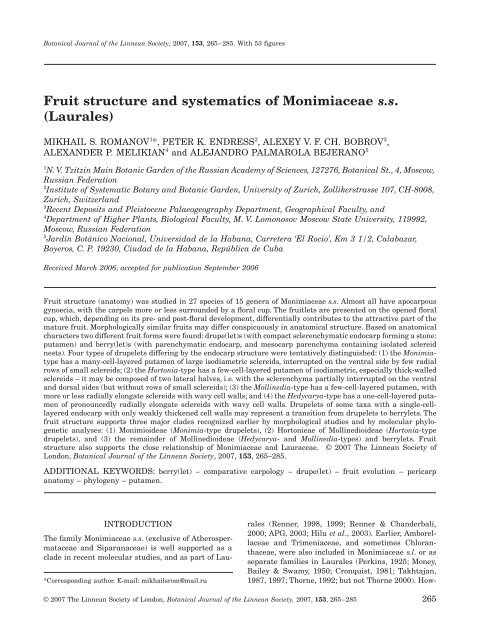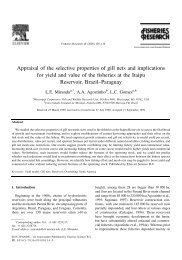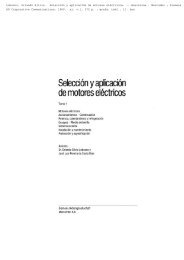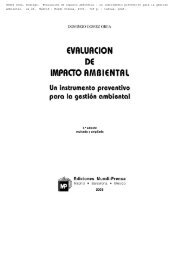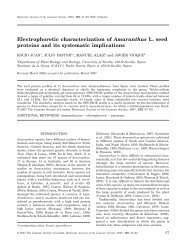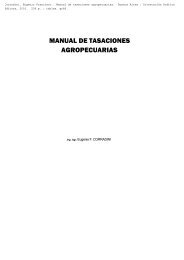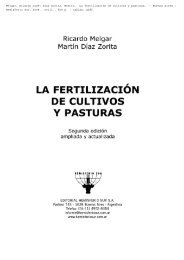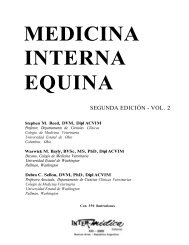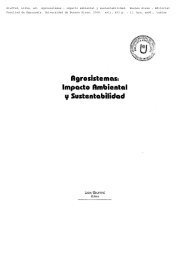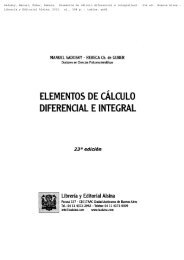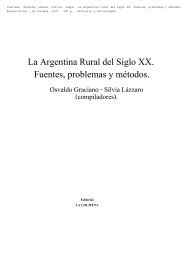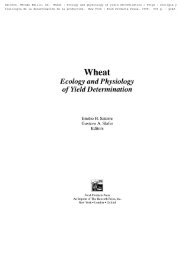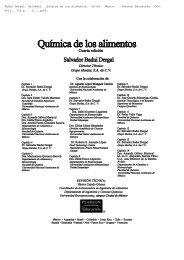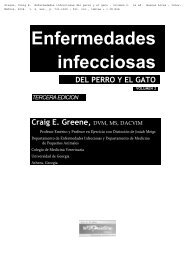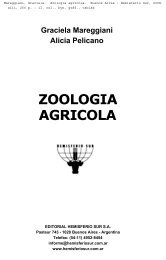Fruit structure and systematics of Monimiaceae ss - Red de Bibliotecas
Fruit structure and systematics of Monimiaceae ss - Red de Bibliotecas
Fruit structure and systematics of Monimiaceae ss - Red de Bibliotecas
You also want an ePaper? Increase the reach of your titles
YUMPU automatically turns print PDFs into web optimized ePapers that Google loves.
Blackwell Publishing LtdOxford, UKBOJBotanical Journal <strong>of</strong> the Linnean Society0024-4074(c) 2007 The Linnean Society <strong>of</strong> London? 2007<br />
153••<br />
265285<br />
Original Article<br />
FRUIT STRUCTURE OF MONIMIACEAE<br />
M. S. ROMANOV<br />
Et al<br />
.<br />
Botanical Journal <strong>of</strong> the Linnean Society, 2007, 153, 265–285. With 53 figures<br />
<strong>Fruit</strong> <strong>structure</strong> <strong>and</strong> <strong>systematics</strong> <strong>of</strong> <strong>Monimiaceae</strong> s.s.<br />
(Laurales)<br />
MIKHAIL S. ROMANOV 1 *, PETER K. ENDRESS 2 , ALEXEY V. F. CH. BOBROV 3 ,<br />
ALEXANDER P. MELIKIAN 4 <strong>and</strong> ALEJANDRO PALMAROLA BEJERANO 5<br />
1 N. V. Tzitzin Main Botanic Gar<strong>de</strong>n <strong>of</strong> the Ru<strong>ss</strong>ian Aca<strong>de</strong>my <strong>of</strong> Sciences, 127276, Botanical St., 4, Moscow,<br />
Ru<strong>ss</strong>ian Fe<strong>de</strong>ration<br />
2 Institute <strong>of</strong> Systematic Botany <strong>and</strong> Botanic Gar<strong>de</strong>n, University <strong>of</strong> Zurich, Zollikerstra<strong>ss</strong>e 107, CH-8008,<br />
Zurich, Switzerl<strong>and</strong><br />
3 Recent Deposits <strong>and</strong> Pleistocene Palaeogeography Department, Geographical Faculty, <strong>and</strong><br />
4 Department <strong>of</strong> Higher Plants, Biological Faculty, M. V. Lomonosov Moscow State University, 119992,<br />
Moscow, Ru<strong>ss</strong>ian Fe<strong>de</strong>ration<br />
5 Jardín Botánico Nacional, Universidad <strong>de</strong> la Habana, Carretera ‘El Rocio’, Km 3 1/2, Calabazar,<br />
Boyeros, C. P. 19230, Ciudad <strong>de</strong> la Habana, República <strong>de</strong> Cuba<br />
Received March 2006; accepted for publication September 2006<br />
<strong>Fruit</strong> <strong>structure</strong> (anatomy) was studied in 27 species <strong>of</strong> 15 genera <strong>of</strong> <strong>Monimiaceae</strong> s.s. Almost all have apocarpous<br />
gynoecia, with the carpels more or le<strong>ss</strong> surroun<strong>de</strong>d by a floral cup. The fruitlets are presented on the opened floral<br />
cup, which, <strong>de</strong>pending on its pre- <strong>and</strong> post-floral <strong>de</strong>velopment, differentially contributes to the attractive part <strong>of</strong> the<br />
mature fruit. Morphologically similar fruits may differ conspicuously in anatomical <strong>structure</strong>. Based on anatomical<br />
characters two different fruit forms were found: drupe(let)s (with compact sclerenchymatic endocarp forming a stone:<br />
putamen) <strong>and</strong> berry(let)s (with parenchymatic endocarp, <strong>and</strong> mesocarp parenchyma containing isolated sclereid<br />
nests). Four types <strong>of</strong> drupelets differing by the endocarp <strong>structure</strong> were tentatively distinguished: (1) the Monimiatype<br />
has a many-cell-layered putamen <strong>of</strong> large isodiametric sclereids, interrupted on the ventral si<strong>de</strong> by few radial<br />
rows <strong>of</strong> small sclereids; (2) the Hortonia-type has a few-cell-layered putamen <strong>of</strong> isodiametric, especially thick-walled<br />
sclereids – it may be composed <strong>of</strong> two lateral halves, i.e. with the sclerenchyma partially interrupted on the ventral<br />
<strong>and</strong> dorsal si<strong>de</strong>s (but without rows <strong>of</strong> small sclereids); (3) the Mollinedia-type has a few-cell-layered putamen, with<br />
more or le<strong>ss</strong> radially elongate sclereids with wavy cell walls; <strong>and</strong> (4) the Hedycarya-type has a one-cell-layered putamen<br />
<strong>of</strong> pronouncedly radially elongate sclereids with wavy cell walls. Drupelets <strong>of</strong> some taxa with a single-celllayered<br />
endocarp with only weakly thickened cell walls may represent a transition from drupelets to berrylets. The<br />
fruit <strong>structure</strong> supports three major cla<strong>de</strong>s recognized earlier by morphological studies <strong>and</strong> by molecular phylogenetic<br />
analyses: (1) Monimioi<strong>de</strong>ae (Monimia-type drupelets), (2) Hortonieae <strong>of</strong> Mollinedioi<strong>de</strong>ae (Hortonia-type<br />
drupelets), <strong>and</strong> (3) the remain<strong>de</strong>r <strong>of</strong> Mollinedioi<strong>de</strong>ae (Hedycarya- <strong>and</strong> Mollinedia-types) <strong>and</strong> berrylets. <strong>Fruit</strong><br />
<strong>structure</strong> also supports the close relationship <strong>of</strong> <strong>Monimiaceae</strong> <strong>and</strong> Lauraceae. © 2007 The Linnean Society <strong>of</strong><br />
London, Botanical Journal <strong>of</strong> the Linnean Society, 2007, 153, 265–285.<br />
ADDITIONAL KEYWORDS: berry(let) – comparative carpology – drupe(let) – fruit evolution – pericarp<br />
anatomy – phylogeny – putamen.<br />
INTRODUCTION<br />
*Corresponding author. E-mail: mikhailsrom@mail.ru<br />
The family <strong>Monimiaceae</strong> s.s. (exclusive <strong>of</strong> Atherospermataceae<br />
<strong>and</strong> Siparunaceae) is well supported as a<br />
cla<strong>de</strong> in recent molecular studies, <strong>and</strong> as part <strong>of</strong> Laurales<br />
(Renner, 1998, 1999; Renner & Ch<strong>and</strong>erbali,<br />
2000; APG, 2003; Hilu et al., 2003). Earlier, Amborellaceae<br />
<strong>and</strong> Trimeniaceae, <strong>and</strong> sometimes Chloranthaceae,<br />
were also inclu<strong>de</strong>d in <strong>Monimiaceae</strong> s.l. or as<br />
separate families in Laurales (Perkins, 1925; Money,<br />
Bailey & Swamy, 1950; Cronquist, 1981; Takhtajan,<br />
1987, 1997; Thorne, 1992; but not Thorne 2000). How-<br />
© 2007 The Linnean Society <strong>of</strong> London, Botanical Journal <strong>of</strong> the Linnean Society, 2007, 153, 265–285 265
266 M. S. ROMANOV ET AL.<br />
ever, Amborellaceae <strong>and</strong> Trimeniaceae were found to<br />
be among the basalmost angiosperms <strong>and</strong> Chloranthaceae<br />
to be isolated <strong>and</strong> difficult to place, <strong>and</strong> thus<br />
all three families had to be exclu<strong>de</strong>d not only from<br />
<strong>Monimiaceae</strong> but also from Laurales (e.g. Mathews &<br />
Donoghue, 1999; Qiu et al., 1999, 2005; Soltis, Soltis &<br />
Chase, 1999; APG, 2003). The isolated position <strong>of</strong><br />
Amborellaceae is also supported by floral <strong>and</strong> carpological<br />
features (Endre<strong>ss</strong> & Igersheim, 2000; Bobrov<br />
et al., 2005). In molecular phylogenetic studies Monimia,<br />
Palmeria <strong>and</strong> Peumus form a cla<strong>de</strong>, which is sister<br />
to the other <strong>Monimiaceae</strong> s.s. (Renner, 1998, 1999,<br />
2002; Renner & Ch<strong>and</strong>erbali, 2000). The distinctne<strong>ss</strong><br />
<strong>of</strong> this group was also recognized by morphologists<br />
(Philipson, 1993; Takhtajan, 1997); this cla<strong>de</strong> is now<br />
treated as subfamily Monimioi<strong>de</strong>ae (Philipson, 1987),<br />
<strong>and</strong> the other members <strong>of</strong> the family as Mollinedioi<strong>de</strong>ae.<br />
Within Mollinedioi<strong>de</strong>ae, Hortonia is sister to<br />
the other genera (Renner, 1998, 1999, 2002; Renner &<br />
Ch<strong>and</strong>erbali, 2000). The Madagascan Decary<strong>de</strong>ndron<br />
<strong>and</strong> Tambouri<strong>ss</strong>a form a (weakly supported) cla<strong>de</strong>,<br />
which is sister to all other remaining genera (Renner,<br />
2002). The bulk <strong>of</strong> the genera, comprising the South<br />
American <strong>and</strong> most Australasian groups, form a<br />
mo<strong>de</strong>rately supported cla<strong>de</strong> (not including Xymalos,<br />
Hedycarya, Levieria or Kibaropsis) (Renner, 2002).<br />
The relationships <strong>of</strong> some <strong>of</strong> these groups are still<br />
unresolved, <strong>and</strong> there is no agreement also from a<br />
structural point <strong>of</strong> view (Endre<strong>ss</strong>, 1980b; Philipson,<br />
1993; Bobrov et al., 2003b).<br />
The representatives <strong>of</strong> <strong>Monimiaceae</strong> s.s. are characterized<br />
by apocarpous gynoecia with uniovulate carpels<br />
(Endre<strong>ss</strong> & Igersheim, 1997). The carpels are<br />
borne in a more or le<strong>ss</strong> flat or concave floral cup (Perkins<br />
& Gilg, 1901; Perkins, 1925; Endre<strong>ss</strong>, 1980a, b;<br />
Endre<strong>ss</strong> & Lorence, 1983; Lorence, 1985; Philipson,<br />
1986, 1993; Romanov & Bobrov, 2002). Tambouri<strong>ss</strong>a<br />
species have inferior ovaries congenitally fused with<br />
the floral cup, which results in a kind <strong>of</strong> syncarpous<br />
gynoecium (Endre<strong>ss</strong>, 1979, 1980b; Endre<strong>ss</strong> & Lorence,<br />
1983; Lorence, 1985). The upper part <strong>of</strong> the floral cup<br />
either abscises from the base just after anthesis<br />
(rarely the cup is small from the beginning without<br />
absci<strong>ss</strong>ion nece<strong>ss</strong>ary), or it encloses the <strong>de</strong>veloping<br />
fruitlets <strong>and</strong> grows with them up to maturity <strong>and</strong> then<br />
splits open with irregular valves (Endre<strong>ss</strong>, 1980b;<br />
Lorence, 1985). In the first case, the unabscised base<br />
<strong>of</strong> the floral cup exp<strong>and</strong>s only as much as to accommodate<br />
the growing fruitlets <strong>and</strong> is commonly inconspicuous<br />
at fruit maturity (e.g. Steganthera <strong>and</strong> Wilkiea<br />
species), or exp<strong>and</strong>s slightly more (Levieria), or the stipes<br />
<strong>of</strong> the druplelets slightly enlarge (Steganthera,<br />
Mollinedia), providing some colour contrast (see figures<br />
in Renner & Hausner, 1997; Cooper & Cooper,<br />
2004). In the second case, the entire floral cup takes<br />
consi<strong>de</strong>rable part in the presentation <strong>of</strong> the fruitlets<br />
by contrasting colours (e.g. Hennecartia, Monimia,<br />
Palmeria <strong>and</strong> Tambouri<strong>ss</strong>a species) (Perkins & Gilg,<br />
1901; Money et al., 1950; Endre<strong>ss</strong>, 1980b; Lorence,<br />
1985; Philipson, 1986, 1993). As the outer part <strong>of</strong> the<br />
pericarp <strong>of</strong> the fruitlets <strong>of</strong> many <strong>Monimiaceae</strong> s.s.<br />
appears to be fleshy or pulpy <strong>and</strong> the inner zone hard,<br />
the fruitlets <strong>of</strong> the representatives <strong>of</strong> the family have<br />
usually been referred to as drupe(let)s (Baillon, 1867–<br />
69; Perkins & Gilg, 1901; Money et al., 1950; Takhtajan,<br />
1966, 1997; Corner, 1976; Cronquist, 1981;<br />
Lorence, 1985; Philipson, 1986, 1993). However, that<br />
such superficially similar fruitlets may be internally<br />
different has been shown by the genus Amborella,<br />
which was found to be unrelated to <strong>Monimiaceae</strong> but<br />
sister to all other extant angiosperms (e.g. Qiu et al.,<br />
1999), <strong>and</strong> in which the seeming druplets have a hard<br />
part that is mainly <strong>de</strong>rived from the mesocarp,<br />
whereas the endocarp is thin (Bobrov et al., 2005).<br />
This result in Amborella prompted us to un<strong>de</strong>rtake a<br />
comparative anatomical study on the fruit <strong>structure</strong> in<br />
a broad array <strong>of</strong> <strong>Monimiaceae</strong> s.s. in or<strong>de</strong>r to elucidate<br />
the diversity <strong>and</strong> to pursue further the systematic significance<br />
<strong>of</strong> the fruits in basal angiosperms.<br />
MATERIAL AND METHODS<br />
Part <strong>of</strong> the studied material (Table 1) was dry, part<br />
was fixed in FAA <strong>and</strong> stored in ethanol (70%). Dry<br />
fruitlets were treated in Strasburger solution (glycerin/ethanol);<br />
they were embed<strong>de</strong>d in paraffin, <strong>and</strong><br />
transverse (TS) <strong>and</strong> longitudinal sections (LS) at 10–<br />
20 µm were ma<strong>de</strong> with a sli<strong>de</strong> microtome. The sections<br />
were stained with phloroglucinol <strong>and</strong> hydrochloric<br />
acid to study <strong>de</strong>tails <strong>of</strong> lignification <strong>of</strong> cell walls in different<br />
topographical zones <strong>of</strong> the pericarp, <strong>and</strong> were<br />
preserved in glycerin. St<strong>and</strong>ard morphological <strong>and</strong><br />
anatomical procedures were used (Bondartzev, 1954;<br />
Prozina, 1960; O’Brien & McCully, 1981). The liquidfixed<br />
fruitlets were embed<strong>de</strong>d in Kulzer’s Technovit<br />
7100 [2-hydroxyethyl methacrylate (HEMA)], sectioned<br />
at 10 µm with a rotary microtome (Microm HM<br />
355), stained with ruthenium red <strong>and</strong> toluidine blue,<br />
<strong>and</strong> enclosed in Histomount (following Weber & Igersheim,<br />
1994). The microtome sections were studied<br />
with light microscopy. <strong>Fruit</strong>let <strong>structure</strong> was also<br />
examined with scanning electron microscopy (‘HITA-<br />
CHI’ S-405-A <strong>and</strong> Camscan S-2), after critical-point<br />
drying <strong>and</strong> sputter-coating with gold–palladium.<br />
RESULTS<br />
All genera <strong>of</strong> <strong>Monimiaceae</strong> s.s. (except Tambouri<strong>ss</strong>a)<br />
have free carpels that <strong>de</strong>velop into free fruitlets. In<br />
these the pericarp is differentiated into three histogenetic<br />
zones (exocarp, mesocarp <strong>and</strong> endocarp) <strong>and</strong> into<br />
three or more histological zones.<br />
© 2007 The Linnean Society <strong>of</strong> London, Botanical Journal <strong>of</strong> the Linnean Society, 2007, 153, 265–285
FRUIT STRUCTURE OF MONIMIACEAE 267<br />
Table 1. Investigated species <strong>and</strong> specimens<br />
Hedycarya angustifolia A.Cunn., mature fruits (liquid-fixed), P.K. Endre<strong>ss</strong>, # 5033, Australia 1980 (Z)<br />
Hedycarya arborea J.R.Forst. & G.Forst., mature fruits (liquid-fixed), P.K. Endre<strong>ss</strong>, # 6390, New Zeal<strong>and</strong> 1981 (Z)<br />
Hedycarya cf. chrysophylla Perkins, mature fruits (liquid-fixed), P.K. Endre<strong>ss</strong>, # 6322, New Caledonia 1981 (Z)<br />
Hedycarya cra<strong>ss</strong>ifolia Gillespie, mature fruits (dry), A.C. Smith, # 5149, Fiji 1947 (LE)<br />
Hedycarya cupulata Baill., mature fruits (dry), G. McPherson, # 1783, New Caledonia 1979 (LE)<br />
Hedycarya <strong>de</strong>ntata G.Forst., mature fruits (dry), M. Hombron, s.n., New Zeal<strong>and</strong> 1841 (LE)<br />
Hedycarya dorstenioi<strong>de</strong>s A.Gray, mature fruits (dry), A.C. Smith, # 6954, Viti Levu 1947 (LE)<br />
Hedycarya parvifolia Perkins & Schltr., mature fruits (dry), G. McPherson, # 1621, New Caledonia 1979 (LE)<br />
Hennecartia omphal<strong>and</strong>ra Poi<strong>ss</strong>., mature fruits (dry), J.E. Montes, # 9515, Brazil 1950 (LE)<br />
Hortonia floribunda Wight ex Arn., mature fruits (dry), R. Wight, # 2491, Sri Lanka 1836 (LE)<br />
Hortonia ovalifolia Wight, mature fruits (dry), L. Bernardi, # 15947, Sri Lanka 1975 (LE)<br />
Kibara coriacea Hook.f. & Thomson, mature fruits (dry), M. Ramos, # 4317, Philippines 1923 (LE)<br />
Kibaropsis caledonica (Guillaumin) Jérémie, mature fruits (liquid-fixed), P.K. Endre<strong>ss</strong>, # 6311, New Caledonia 1981 (Z)<br />
Levieria nitens Perkins, mature fruits (dry), H.O. Forbes, # 702, New Guinea 1885–86 (LE)<br />
Matthaea pubescens Merr. ex Perkins, mature fruits (dry), A.D.E. Elmer, # 10699, Philippines 1909 (LE)<br />
Mollinedia elliptica A.DC., mature fruits (dry), L. Rie<strong>de</strong>l & B. Luschnath, # 312, Brazil 1832 (LE)<br />
Mollinedia stenophylla Perkins, mature fruits (dry), L. Rie<strong>de</strong>l & B. Luschnath, # 315, Brazil 1832 (LE)<br />
Monimia rotundifolia Thouars, mature fruits (dry), L. Boivin, # 1120, La Réunion, s.d. (LE)<br />
Peumus boldus Molina, mature fruits (dry), O. Zalensky, # 15, Chile 1968 (LE)<br />
Palmeria sc<strong>and</strong>ens F.Muell., mature fruits (dry), P. Melville, # 3613, Queensl<strong>and</strong>, Australia 1953 (LE)<br />
Steganthera ilicifolia A.C.Sm., mature fruits (liquid-fixed), P.K. Endre<strong>ss</strong>, # 4074, Papua New Guinea 1977 (Z)<br />
Steganthera fengeriana Perkins, mature fruits (dry), T.G. Hartley, # 9967, New Guinea 1962 (LE)<br />
Steganthera salomonensis Philipson, mature fruits (dry), P.F. Hunt, # 2415, Solomon Isl<strong>and</strong>s, s.d. (LE)<br />
Tambouri<strong>ss</strong>a comorensis Lorence, mature fruits (dry), L. Bernardi, # 11803, Comores 1967 (LE)<br />
Tambouri<strong>ss</strong>a tau Lorence, mature fruits (liquid-fixed), D.H. Lorence, # 2950, Mauritius 1979 (Z)<br />
Tetrasyn<strong>and</strong>ra laxiflora Perkins, mature fruits (dry), M.S. Clemens, s.n., Queensl<strong>and</strong>, Australia 1947 (LE)<br />
Wilkiea war<strong>de</strong>llii (F.Muell.) Perkins, mature fruits (dry), F. von Mueller, s.n., Queensl<strong>and</strong>, Australia, s.d. (LE)<br />
MONIMIA ROTUNDIFOLIA<br />
The several (5–10) carpels <strong>de</strong>velop into few drupelets.<br />
They remain enclosed by the floral cup. Only at maturity<br />
does the floral cup <strong>de</strong>hisce into 3–5 irregular<br />
valves <strong>and</strong> the irregularly flattened drupelets are<br />
exposed (Lorence, 1985) (Fig. 50). The inner surface <strong>of</strong><br />
the floral cup forms a colour contrast with the drupelets<br />
(red vs. orange in Monimia ovalifolia; D. H.<br />
Lorence, pers. comm.).<br />
The pericarp is differentiated into four distinct histological<br />
zones (Fig. 5). The first zone (the exocarp)<br />
consists <strong>of</strong> the one-cell-layered epi<strong>de</strong>rmis <strong>of</strong> small,<br />
flattened, ellipsoidal tanniferous cells, <strong>and</strong> with a thin<br />
cuticle. The second <strong>and</strong> third zones are formed by the<br />
mesocarp. The second zone consists <strong>of</strong> 3–8 layers <strong>of</strong><br />
thin-walled parenchymatic cells, interspersed with<br />
numerous large, spherical–ellipsoidal, thin-walled<br />
resiniferous cells. The vascular system is situated in<br />
the inner area <strong>of</strong> the second zone, with the vascular<br />
bundles situated above the ribs <strong>of</strong> the endocarp. The<br />
third zone consists <strong>of</strong> 1–5 layers <strong>of</strong> small, flattened,<br />
tangentially elongate cells with unevenly insignificantly<br />
thickened cell walls, the zone <strong>of</strong> hydrocytes. The<br />
fourth zone (the endocarp), making up about threequarters<br />
<strong>of</strong> the pericarp thickne<strong>ss</strong>, is composed <strong>of</strong> 13–<br />
21 layers <strong>of</strong> large, isodiametric sclereids with thickened,<br />
lignified, striate, canaliculate, broadly wavy cell<br />
walls (Fig. 29). The innermost layers <strong>of</strong> the endocarp<br />
are formed by insignificantly tangentially orientated<br />
sclereids. In the ventral median plane <strong>of</strong> the endocarp<br />
there are two radial rows <strong>of</strong> smaller sclereids with<br />
somewhat le<strong>ss</strong> thickened walls, which appear to result<br />
in a fainter area <strong>of</strong> the putamen (Figs 28, 50). The<br />
periphery <strong>of</strong> the endocarp is irregularly zigzag-shaped<br />
in TS <strong>and</strong> LS. The cuticle <strong>of</strong> the inner epi<strong>de</strong>rmis is<br />
inconspicuous.<br />
PALMERIA SCANDENS<br />
The several carpels <strong>de</strong>velop into (few) drupelets. They<br />
remain enclosed by the floral cup. Only at maturity<br />
does the floral cup <strong>de</strong>hisce into several irregular<br />
valves <strong>and</strong> the irregularly flattened drupelets are<br />
exposed. The red inner surface <strong>of</strong> the floral cup displays<br />
a colour contrast with the black drupelets (Cooper<br />
& Cooper, 2004; P.K.E., pers. observ.). The fruits <strong>of</strong><br />
P. gracilis are similar (Fig. 1).<br />
The pericarp is differentiated into five distinct histological<br />
zones (Figs 6, 30). The first zone (the exocarp)<br />
is formed by the one-cell-layered epi<strong>de</strong>rmis <strong>of</strong><br />
ellipsoidally rectangular cells with evenly thickened<br />
cell walls, the cell walls dark by tannins, <strong>and</strong> with a<br />
© 2007 The Linnean Society <strong>of</strong> London, Botanical Journal <strong>of</strong> the Linnean Society, 2007, 153, 265–285
268 M. S. ROMANOV ET AL.<br />
Figures 1–4. Mature fruits. Fig. 1. Palmeria gracilis Perkins. Fig. 2. Tambouri<strong>ss</strong>a castri-<strong>de</strong>lphinii Cavaco (courtesy W.<br />
Barthlott). Fig. 3. Hedycarya arborea. Fig. 4. Wilkiea huegeliana A.DC.<br />
thick, even cuticle. The second, third <strong>and</strong> fourth zones<br />
are formed by the mesocarp. The second zone consists<br />
<strong>of</strong> 1–2 layers <strong>of</strong> large, spherical or ellipsoidal, thinwalled<br />
resiniferous cells. The third zone is formed by<br />
5–6 layers <strong>of</strong> large, spherical, thin-walled ethereal oil<br />
cells, interspersed with few small, thin-walled cells.<br />
The vascular system is situated in the third zone. The<br />
fourth zone is represented by 1–2 layers <strong>of</strong> small,<br />
ellipsoidal–angular hydrocytes with unevenly thickened<br />
cell walls. The fifth zone (the endocarp), representing<br />
up to three-quarters <strong>of</strong> the pericarp thickne<strong>ss</strong>,<br />
is formed by 40–55 layers <strong>of</strong> isodiametric sclereids<br />
with heavily thickened, lignified, striate, canaliculate,<br />
somewhat wavy cell walls (Fig. 31). In the ventral<br />
median plane <strong>of</strong> the endocarp there are 2(−5) radial<br />
rows <strong>of</strong> radially elongate, thick-walled sclereids,<br />
which appear to result in a fainter area <strong>of</strong> the<br />
putamen. The cuticle <strong>of</strong> the inner epi<strong>de</strong>rmis is<br />
inconspicuous.<br />
PEUMUS BOLDUS<br />
The 3–5 carpels <strong>de</strong>velop into 2–5 drupelets (Perkins,<br />
1925). The upper part <strong>of</strong> the floral cup abscises with a<br />
ring-shaped absci<strong>ss</strong>ion zone (Martínez-Labor<strong>de</strong>, 1983;<br />
Philipson, 1993). However, it is not clear whether this<br />
takes place in the ripe fruit or earlier. At maturity the<br />
drupelets are exposed on the inner si<strong>de</strong> <strong>of</strong> the remaining<br />
part <strong>of</strong> the floral cup.<br />
The pericarp is differentiated into three histological<br />
zones (Figs 7, 32). The first zone (the exocarp) is represented<br />
by a one-cell-layered epi<strong>de</strong>rmis <strong>of</strong> tangentially<br />
elongate, rectangular tanniferous cells with<br />
unevenly thickened cell walls <strong>and</strong> with a thick, even<br />
cuticle. The second zone (the mesocarp) consists <strong>of</strong> 15–<br />
25 layers <strong>of</strong> irregularly ellipsoidal, thin-walled tanniferous<br />
cells, interspersed with large, spherical–ellipsoidal,<br />
thin-walled etheral oil cells. The vascular system<br />
is situated in the middle part <strong>of</strong> the mesocarp. The<br />
third zone (the endocarp), representing up to fourfifths<br />
<strong>of</strong> the pericarp thickne<strong>ss</strong>, consists <strong>of</strong> 15–25 layers<br />
<strong>of</strong> isodiametric sclereids with heavily thickened,<br />
lignified, striate, canaliculate, somewhat wavy cell<br />
walls (Fig. 33). In the ventral median plane <strong>of</strong> the<br />
endocarp the putamen is interrupted by an area <strong>of</strong> few<br />
(2–3) radial rows <strong>of</strong> smaller-celled sclereids (Fig. 32).<br />
The cuticle <strong>of</strong> the inner epi<strong>de</strong>rmis is thin <strong>and</strong><br />
inconspicuous.<br />
© 2007 The Linnean Society <strong>of</strong> London, Botanical Journal <strong>of</strong> the Linnean Society, 2007, 153, 265–285
FRUIT STRUCTURE OF MONIMIACEAE 269<br />
Figures 5–10. Schematic TS <strong>of</strong> pericarp <strong>of</strong> mature fruitlets (En = endocarp; Ex = exocarp; Fc = floral cup; M = mesocarp;<br />
dark grey = resin cells; light grey = ethereal oil cells; hatched = hydrocytes; black = tanniferous cells, also cells with tannins<br />
in cell walls). Fig. 5. Monimia rotundifolia. Fig. 6. Palmeria sc<strong>and</strong>ens. Fig. 7. Peumus boldus. Fig. 8. Hortonia floribunda.<br />
Fig. 9. Tambouri<strong>ss</strong>a comorensis. Fig. 10. Kibaropsis caledonica. Scale bars: Figs 5–9 = 0.1 mm; Fig. 10 = 0.05 mm.<br />
© 2007 The Linnean Society <strong>of</strong> London, Botanical Journal <strong>of</strong> the Linnean Society, 2007, 153, 265–285
270 M. S. ROMANOV ET AL.<br />
Figures 11–16. Schematic TS <strong>of</strong> pericarp <strong>of</strong> mature fruitlets (En = endocarp; Ex = exocarp; M = mesocarp; dark<br />
grey = resin cells; light grey = ethereal oil cells; hatched = hydrocytes; black = tanniferous cells, also cells with tannins in<br />
cell walls). Fig. 11. Levieria nitens. Fig. 12. Hedycarya cupulata, Fig. 13. Hedycarya dorrstenioi<strong>de</strong>s. Fig. 14. Mollinedia<br />
elliptica. Fig. 15. Mollinedia stenophylla. Fig. 16. Hennecartia omphal<strong>and</strong>ra. Scale bars: Figs 11, 12, 14, 15 = 0.05 mm;<br />
Fig. 13 = 0.1 mm; Fig. 15 = 0.03 mm.<br />
© 2007 The Linnean Society <strong>of</strong> London, Botanical Journal <strong>of</strong> the Linnean Society, 2007, 153, 265–285
FRUIT STRUCTURE OF MONIMIACEAE 271<br />
Figures 17–21. Schematic TS <strong>of</strong> pericarp <strong>of</strong> mature fruitlets (En = endocarp; Ex = exocarp; M = mesocarp; dark<br />
grey = resin cells; light grey = ethereal oil cells; hatched = hydrocytes; black = tanniferous cells, also cells with tannins in<br />
cell walls). Fig. 17. Wilkiea war<strong>de</strong>llii. Fig. 18. Kibara coriacea. Fig. 19. Steganthera salomonensis. Fig. 20. Tetrasyn<strong>and</strong>ra<br />
laxiflora. Fig. 21. Matthaea pubescens. Scale bars: Fig. 17 = 0.05 mm; Figs 18–21 = 0.1 mm.<br />
© 2007 The Linnean Society <strong>of</strong> London, Botanical Journal <strong>of</strong> the Linnean Society, 2007, 153, 265–285
272 M. S. ROMANOV ET AL.<br />
Figures 22–27. Microtome TS <strong>of</strong> pericarp <strong>of</strong> mature or submature fruitlets (fruit in Fig. 27) (stained with ruthenium red<br />
<strong>and</strong> toluidine blue) (En = endocarp; Ex = exocarp; M = mesocarp; Sc = seed coat). Fig. 22. Tambouri<strong>ss</strong>a tau Lorence. Fig. 23.<br />
Kibaropsis caledonica Jérémie. Fig. 24. Hedycarya angustifolia A. Cunn. Fig. 25. Hedycarya arborea. Fig. 26. Steganthera<br />
ilicifolia A.C. Sm. Fig. 27. Laurus nobilis L. (Lauraceae). Scale bars: Figs 22, 24–27 = 0.2 mm; Fig. 23 = 0.1 mm.<br />
© 2007 The Linnean Society <strong>of</strong> London, Botanical Journal <strong>of</strong> the Linnean Society, 2007, 153, 265–285
FRUIT STRUCTURE OF MONIMIACEAE 273<br />
Figures 28–33. SEM micrographs <strong>of</strong> TS (LS in Fig. 28) <strong>of</strong> pericarp (En = endocarp; Eoc = ethereal oil cell; Ex = exocarp;<br />
M = mesocarp). Figs 28, 29. Monimia rotundifolia. Fig. 28. LS, endocarp with partly torn weaker area <strong>of</strong> small sclereids<br />
(arrow) in apical part, corresponding to the area with smaller sclereids on the ventral si<strong>de</strong>. Fig. 29. Endocarp. Figs 30, 31.<br />
Palmeria sc<strong>and</strong>ens. Fig. 30. Lateral si<strong>de</strong>, pericarp. Fig. 31. Endocarp. Figs 32, 33. Peumus boldus. Fig. 32. Ventral si<strong>de</strong>,<br />
endocarp with radial area <strong>of</strong> small sclereids (narrow arrow); broad arrows point to vascular bundles. Fig. 33. Close-up <strong>of</strong><br />
outer part <strong>of</strong> pericarp. Scale bars: Figs 28, 30, 32 = 0.3 mm; Figs 29, 31, 33 = 0.03 mm.<br />
© 2007 The Linnean Society <strong>of</strong> London, Botanical Journal <strong>of</strong> the Linnean Society, 2007, 153, 265–285
274 M. S. ROMANOV ET AL.<br />
HORTONIA FLORIBUNDA<br />
The several carpels <strong>de</strong>velop into few fruitlets. At<br />
maturity the shortly stipitate drupelets are presented<br />
on the small, reflexed floral cup. The fruitlet outline is<br />
elliptic in TS (smaller in lateral direction than in<br />
median direction) (Fig. 51).<br />
The pericarp is differentiated into four distinct histological<br />
zones (Figs 8, 34, 35). The first zone (the exocarp)<br />
consists <strong>of</strong> the one-cell-layered epi<strong>de</strong>rmis <strong>of</strong><br />
large roundish–rectangular cells, with evenly thickened<br />
walls, the walls dark by tannins <strong>and</strong> with a thick<br />
uneven cuticle. The second <strong>and</strong> third zones are formed<br />
by the mesocarp. The second zone consists <strong>of</strong> 20–28<br />
layers <strong>of</strong> thin-walled, irregularly ellipsoidal, somewhat<br />
tangentially elongate cells, interspersed with<br />
numerous large spherical–ellipsoidal, thin-walled<br />
resiniferous cells; there are also some large resiniferous<br />
sclereids with thickened, lignified cell walls. Tanniferous<br />
cells are present in the outer 3–8 cell layers,<br />
<strong>and</strong> also cells with tannins in the cell walls. The vascular<br />
system is situated in the middle area <strong>of</strong> the second<br />
zone. The third zone comprises 2–6 layers <strong>of</strong><br />
angular–ellipsoidal, tangentially elongate hydrocytes<br />
with reticulate cell-wall thickening. The fourth zone<br />
(the endocarp) consists <strong>of</strong> 3–6 layers <strong>of</strong> large, roundish–multiangular<br />
resiniferous sclereids <strong>of</strong> unequal<br />
size, with exceedingly thickened, lignified, striate,<br />
canaliculate cell walls. The endocarp (putamen) is protruding<br />
ventrally <strong>and</strong> dorsally in the median plane<br />
forming two ridges. The inner morphological surface is<br />
similarly protruding but appears not to reach the<br />
periphery <strong>of</strong> the endocarp, which results in two<br />
’valves’ (Figs 34, 35, 51). The cuticle <strong>of</strong> the inner epi<strong>de</strong>rmis<br />
is thin <strong>and</strong> even.<br />
Hortonia ovalifolia differs by the presence <strong>of</strong> more<br />
numerous resiniferous sclereids in the second zone,<br />
only 1–2 layers <strong>of</strong> hydrocytes forming the third zone,<br />
le<strong>ss</strong>er thickening <strong>of</strong> the sclereid cell walls in the<br />
endocarp, <strong>and</strong> lack <strong>of</strong> ventral <strong>and</strong> dorsal ridges in the<br />
endocarp.<br />
TAMBOURISSA COMORENSIS<br />
The fruit in Tambouri<strong>ss</strong>a is unusual because the ovaries<br />
are inferior, immersed in the floral cup, which<br />
results in an unusual kind <strong>of</strong> syncarpous fruit<br />
(Endre<strong>ss</strong>, 1980b; Endre<strong>ss</strong> & Lorence, 1983; Lorence,<br />
1985). Therefore, an exocarp that surrounds each individual<br />
’fruitlet’ is not present (Fig. 36). However, each<br />
carpel differentiates histological <strong>structure</strong>s that functionally<br />
correspond to a pericarp, which then separates<br />
from the ti<strong>ss</strong>ue <strong>of</strong> the floral cup or neighbouring<br />
carpels. Commonly in the genus the ’fruitlets’ are<br />
orange or red, surroun<strong>de</strong>d by yellow or orange parts <strong>of</strong><br />
the floral cup (Lorence, 1985) (Fig. 2).<br />
The fruit wall is differentiated into five histological<br />
zones <strong>of</strong> which the third <strong>and</strong> fourth are similar to a<br />
mesocarp <strong>and</strong> the fifth to an endocarp (Fig. 9). The<br />
first zone, the outer epi<strong>de</strong>rmis, is part <strong>of</strong> the united<br />
complex <strong>of</strong> carpels <strong>and</strong> floral cup. The second zone is<br />
formed by up to 100 layers <strong>of</strong> isodiametric thin-walled<br />
cells interspersed with numerous spherical thinwalled<br />
ethereal oil cells <strong>and</strong> scattered solitary or<br />
groups <strong>of</strong> 2–13 sclereids with thickened, lignified, striate,<br />
canaliculate cell walls. The sclereids differ from<br />
each other in their wall thickne<strong>ss</strong>. In places the outer<br />
cell layers <strong>of</strong> the second zone divi<strong>de</strong> in tangential<br />
direction <strong>and</strong> form a peri<strong>de</strong>rm composed <strong>of</strong> up to<br />
10–15 indistinct cell layers. The third zone consists <strong>of</strong><br />
15–30 layers <strong>of</strong> small, thin-walled fusiform cells, interspersed<br />
with numerous large, spherical–ellipsoidal,<br />
thin-walled resiniferous <strong>and</strong> ethereal oil cells. The<br />
vascular system is situated in the third zone. The<br />
fourth zone is represented by the one-cell-layered<br />
inner hypo<strong>de</strong>rmis, which is composed <strong>of</strong> tangentially<br />
elongate, ellipsoidal hydrocytes with unevenly thickened<br />
cell walls. The fifth zone (the endocarp) consists<br />
<strong>of</strong> 2–4(−5) layers <strong>of</strong> large unequal sclereids, with thickened,<br />
lignified, striate, canaliculate, pronouncedly<br />
wavy cell walls (Fig. 37). The cuticle <strong>of</strong> the inner epi<strong>de</strong>rmis<br />
is inconspicuous.<br />
Tambouri<strong>ss</strong>a tau differs by fewer secretory cells (i.e.<br />
resiniferous <strong>and</strong> ethereal oil cells) in the third zone,<br />
<strong>and</strong> more pronouncedly tangentially elongate cells<br />
with thickened <strong>and</strong> lignified cell walls in the fourth<br />
zone (Fig. 22).<br />
KIBAROPSIS CALEDONICA<br />
The 40–60 carpels <strong>de</strong>velop into several red drupelets,<br />
which are presented on the reflexed floral cup<br />
(Jérémie, 1977). The fruitlet outline is circular in TS.<br />
The pericarp is differentiated into four distinct histological<br />
zones (Figs 10, 23). The first zone (the exocarp)<br />
consists <strong>of</strong> the one-cell-layered epi<strong>de</strong>rmis <strong>of</strong><br />
rather small, rectangular, thin-walled tanniferous<br />
cells <strong>and</strong> with a thick, wavy cuticle. The second <strong>and</strong><br />
third zones (the mesocarp) consist <strong>of</strong> 55–65 cell layers.<br />
The second zone is represented by 10–12 layers <strong>of</strong> relatively<br />
small, thin-walled parenchymatic cells, interspersed<br />
with small nests <strong>of</strong> up to c. 20 sclereids with<br />
thickened, lignified, striate, canaliculate cell walls.<br />
More than half <strong>of</strong> the thin-walled cells <strong>of</strong> this zone are<br />
tanniferous. The third (<strong>and</strong> thickest) zone is composed<br />
<strong>of</strong> relatively large parenchymatic cells, interspersed<br />
with numerous scattered spherical–ellipsoidal, thinwalled<br />
resiniferous cells. In the inner part <strong>of</strong> this zone<br />
there are numerous ethereal oil cells <strong>and</strong> very few solitary<br />
scattered sclereids with thickened, lignified, striate,<br />
canaliculate, cell walls. The vascular system is<br />
situated in the third zone. The fourth zone (the<br />
© 2007 The Linnean Society <strong>of</strong> London, Botanical Journal <strong>of</strong> the Linnean Society, 2007, 153, 265–285
FRUIT STRUCTURE OF MONIMIACEAE 275<br />
endocarp) consists <strong>of</strong> 7–10 layers <strong>of</strong> large unequal<br />
sclereids, with thickened, lignified, striate, canaliculate,<br />
somewhat wavy cell walls. Some cells are markedly<br />
radially elongate. The cuticle <strong>of</strong> the inner<br />
epi<strong>de</strong>rmis is inconspicuous.<br />
LEVIERIA NITENS<br />
The numerous carpels <strong>de</strong>velop into numerous se<strong>ss</strong>ile<br />
fruitlets, which are presented at maturity on the<br />
reflexed floral cup (Philipson, 1980). The fruitlet outline<br />
is circular in TS.<br />
The pericarp is differentiated into four distinct histological<br />
zones (Figs 11, 38). The first zone (the exocarp)<br />
consists <strong>of</strong> the one-cell-layered epi<strong>de</strong>rmis <strong>of</strong><br />
angular, somewhat tangentially elongate cells, with<br />
unevenly thickened cell walls, <strong>and</strong> with an inconspicuous<br />
cuticle. The second <strong>and</strong> third zones are formed by<br />
the mesocarp. The second zone is composed <strong>of</strong> 25–39<br />
layers <strong>of</strong> small, nearly ellipsoidal, thin-walled parenchymatic<br />
cells, interspersed with numerous large,<br />
spherical–ellipsoidal thin-walled resiniferous cells.<br />
The vascular system is situated in the inner area <strong>of</strong><br />
the second zone. The third zone is irregularly thick,<br />
comprising 1–4 layers <strong>of</strong> angular–ellipsoidal, tangentially<br />
elongate hydrocytes with reticulate cell-wall<br />
thickening. The fourth zone (the endocarp) consists <strong>of</strong><br />
one layer <strong>of</strong> large, radially elongated sclereids, with<br />
heavily thickened, lignified, striate, canaliculate,<br />
broadly wavy cell walls (Fig. 39). The cuticle <strong>of</strong> the<br />
inner epi<strong>de</strong>rmis is inconspicuous.<br />
HEDYCARYA CUPULATA<br />
The 9–15 carpels <strong>de</strong>velop into few black drupelets,<br />
which are presented at maturity on the reflexed floral<br />
cup (Jérémie, 1978). In H. arborea the drupelets are<br />
orange (Fig. 3). The fruitlet outline is circular in TS<br />
(Fig. 53).<br />
The pericarp is differentiated into four distinct histological<br />
zones (Figs 12, 40). The first zone (the exocarp)<br />
consists <strong>of</strong> the one-cell-layered epi<strong>de</strong>rmis <strong>of</strong><br />
large ellipsoidally rectangular cells, with unevenly<br />
thickened walls, <strong>and</strong> is covered by a very thick, even<br />
cuticle. The second <strong>and</strong> third zones are formed by the<br />
mesocarp. The second zone is represented by 10–14<br />
layers <strong>of</strong> thin-walled, fusiform parenchymatic cells,<br />
interspersed with numerous large spherical–ellipsoidal,<br />
thin-walled resiniferous cells. The thin-walled<br />
fusiform cells are smaller in the peripheral part <strong>of</strong><br />
the second zone. The vascular system is situated in<br />
the inner area <strong>of</strong> the second zone. The third zone<br />
comprises 2–4 layers <strong>of</strong> nearly rectangular, tangentially<br />
elongate hydrocytes with reticulate cell-wall<br />
thickening. The fourth zone (the endocarp) consists <strong>of</strong><br />
one layer <strong>of</strong> large, radially elongate sclereids, with<br />
heavily thickened, striate, canaliculate walls. Only<br />
the primary cell walls are lignified. The cell walls are<br />
heavily broadly wavy, which may give the wrong<br />
impre<strong>ss</strong>ion <strong>of</strong> the endocarp as consisting <strong>of</strong> several<br />
cell layers. The cuticle <strong>of</strong> the inner epi<strong>de</strong>rmis is<br />
inconspicuous.<br />
Hedycarya parvifolia differs in more numerous cell<br />
layers <strong>of</strong> the second <strong>and</strong> third zones. In H. angustifolia,<br />
H. cf. chrysophylla <strong>and</strong> H. dorstenioi<strong>de</strong>s the second<br />
zone is more multilayered, but, by contrast, the third<br />
zone is thinner <strong>and</strong> consists <strong>of</strong> a single layer <strong>of</strong> crescent-shaped<br />
hydrocytes (1–2 layers in H. cf. chrysophylla<br />
<strong>and</strong> H. cra<strong>ss</strong>ifolia) (Figs 13, 24, 41). In<br />
H. angustifolia <strong>and</strong> H. cra<strong>ss</strong>ifolia the cells <strong>of</strong> the<br />
endocarp are two or more times shorter (in radial<br />
direction) than in the other studied species. In<br />
H. arborea <strong>and</strong> H. <strong>de</strong>ntata only a single zone is differentiated<br />
in the mesocarp, corresponding to the second<br />
zone in H. cupulata (i.e. the zone <strong>of</strong> hydrocytes is<br />
absent); in the mesocarp scattered nests <strong>of</strong> 1–5 sclereids<br />
with thickened, lignified cell walls are <strong>de</strong>veloped<br />
(Fig. 25).<br />
MOLLINEDIA ELLIPTICA<br />
The 10–12 carpels <strong>de</strong>velop into few se<strong>ss</strong>ile drupelets.<br />
After anthesis the upper part <strong>of</strong> the floral cup abscises<br />
from the lower part so that the fruitlets are not covered<br />
during <strong>de</strong>velopment. At maturity they are presented<br />
on the reflexed floral cup (Perkins & Gilg,<br />
1901). The fruitlet outline is circular in TS (Fig. 52).<br />
The pericarp is differentiated into five distinct histological<br />
zones (Figs 14, 42). The first zone (the exocarp)<br />
consists <strong>of</strong> the one-cell-layered epi<strong>de</strong>rmis <strong>of</strong><br />
large rectangular palisa<strong>de</strong> cells, with unevenly thickened<br />
cell walls <strong>and</strong> triangular lumens, <strong>and</strong> with a<br />
thick, even cuticle. The second, third <strong>and</strong> fourth zones<br />
are formed by the mesocarp. The second zone is represented<br />
by a one-cell-layered hypo<strong>de</strong>rmis composed<br />
<strong>of</strong> square–roun<strong>de</strong>d cells with insignificantly thickened<br />
cell walls. The vascular system is situated in the inner<br />
area <strong>of</strong> the second zone. The third zone consists <strong>of</strong> 15–<br />
25 layers <strong>of</strong> ellipsoidally flattened, thin-walled cells,<br />
interspersed with numerous large, spherical–ellipsoidal,<br />
thin-walled resiniferous cells. Sometimes 1–3<br />
outer cell layers <strong>of</strong> the third zone are represented by<br />
roun<strong>de</strong>d–rectangular, thin-walled cells. The fourth<br />
zone comprises 1–2 layers <strong>of</strong> rather large, ellipsoidal,<br />
tangentially elongate tanniferous hydrocytes. The<br />
fifth zone (the endocarp) consists <strong>of</strong> 2–4 layers <strong>of</strong> large<br />
unequal sclereids, with thickened, lignified, striate,<br />
canaliculate, pronouncedly broadly wavy cell walls<br />
(Fig. 43). The cuticle <strong>of</strong> the inner epi<strong>de</strong>rmis is inconspicuous.<br />
Mollinedia stenophylla differs in the number <strong>of</strong> cell<br />
layers <strong>and</strong> number <strong>of</strong> secretory cells (i.e. resiniferous<br />
© 2007 The Linnean Society <strong>of</strong> London, Botanical Journal <strong>of</strong> the Linnean Society, 2007, 153, 265–285
276 M. S. ROMANOV ET AL.<br />
Figures 34–39. SEM micrographs <strong>of</strong> TS <strong>of</strong> pericarp (En = endocarp; Ex = exocarp; H = hydrocytes; M = mesocarp;<br />
Rc = resin cells; Sc = seed coat). Figs 34, 35. Hortonia floribunda (narrow arrow points to slit in endocarp; broad arrow<br />
points to vascular bundle). Fig. 34. Dorsal si<strong>de</strong>. Fig. 35. Ventral si<strong>de</strong>. Figs 36, 37. Tambouri<strong>ss</strong>a comorensis. Fig. 36. Part<br />
<strong>of</strong> two neighbouring ‘fruitlets’. Fig. 37. Endocarp. Figs 38, 39. Levieria nitens. Fig. 38. Pericarp. Fig. 39. Endocarp. Scale<br />
bars: Figs 34, 35, 37, 38 = 0.1 mm; Fig. 36 = 0.3 mm; Fig. 39 = 0.03 mm.<br />
© 2007 The Linnean Society <strong>of</strong> London, Botanical Journal <strong>of</strong> the Linnean Society, 2007, 153, 265–285
FRUIT STRUCTURE OF MONIMIACEAE 277<br />
<strong>and</strong> etheral oil cells) in the mesocarp, <strong>and</strong> in cell <strong>structure</strong><br />
in the endocarp (Fig. 15).<br />
HENNECARTIA OMPHALANDRA<br />
Of the one or two carpels commonly one <strong>de</strong>velops into<br />
a drupelet (Endre<strong>ss</strong>, 1980b). The drupelet(s) remain(s)<br />
enclosed by the floral cup. Only at maturity does the<br />
floral cup <strong>de</strong>hisce into several irregular valves, <strong>and</strong><br />
the black drupelet is presented on the orange cup surface<br />
(Martínez-Labor<strong>de</strong>, 1983). The fruitlet outline is<br />
circular in TS.<br />
The pericarp is differentiated into three histological<br />
zones (Fig. 16). The first zone (the exocarp) consists <strong>of</strong><br />
the one-cell-layered epi<strong>de</strong>rmis <strong>of</strong> large, square, tanniferous<br />
cells with unevenly thickened cell walls, <strong>and</strong><br />
with a very thick, wavy cuticle, <strong>and</strong> a single-layered<br />
hypo<strong>de</strong>rmis <strong>of</strong> somewhat crushed rectangular, tanniferous<br />
cells, which appears to be <strong>de</strong>rived from the epi<strong>de</strong>rmis,<br />
as suggested by radial cell rows. The second<br />
zone (the mesocarp) comprises 23–30 layers <strong>of</strong> relatively<br />
large parenchymatic cells, interspersed with<br />
numerous large spherical–ellipsoidal, thin-walled<br />
resiniferous cells. In the peripheral area the thinwalled<br />
cells are smaller The vascular system is situated<br />
in the middle part <strong>of</strong> the second zone. The innermost<br />
layer <strong>of</strong> the second zone contains some sclereids<br />
with thickened, lignified cell walls. The third zone (the<br />
endocarp) consists <strong>of</strong> a single layer <strong>of</strong> large, radially<br />
elongate sclereids, with heavily thickened, lignified,<br />
striate, canaliculate cell walls. The primary cell walls<br />
are lignified more heavily. The cell walls are pronouncedly<br />
wavy, which may give the wrong impre<strong>ss</strong>ion<br />
<strong>of</strong> the endocarp as consisting <strong>of</strong> several cell layers. The<br />
cuticle <strong>of</strong> the inner epi<strong>de</strong>rmis is thin.<br />
WILKIEA WARDELLII<br />
The several carpels <strong>de</strong>velop into few stipitate drupelets.<br />
After anthesis the upper part <strong>of</strong> the floral cup<br />
abscises from the lower part so that the fruitlets are<br />
not covered during <strong>de</strong>velopment. At maturity they are<br />
presented on the reflexed yellow remnant <strong>of</strong> the floral<br />
cup. In W. war<strong>de</strong>llii the fruitlets are red but otherwise<br />
in the genus commonly black (Cooper & Cooper, 2004)<br />
(Fig. 4). The fruitlet outline is circular in TS.<br />
The pericarp is differentiated into four histological<br />
zones (Figs 17, 44). The first zone (the exocarp) consists<br />
<strong>of</strong> the one-layered epi<strong>de</strong>rmis <strong>of</strong> rectangular tanniferous<br />
cells <strong>and</strong> with a mo<strong>de</strong>rately <strong>de</strong>veloped even<br />
cuticle. The second <strong>and</strong> third zones are formed by the<br />
mesocarp. The second zone is a one-cell-layered irregular<br />
hypo<strong>de</strong>rmis <strong>of</strong> tanniferous cells, which are rather<br />
small as compared with the cells <strong>of</strong> the third zone. The<br />
third zone consists <strong>of</strong> 23–28 layers <strong>of</strong> large, thinwalled<br />
parenchymatic cells (some <strong>of</strong> which are tanniferous),<br />
interspersed with numerous large, spherical,<br />
thin-walled resiniferous cells. There are numerous solitary<br />
sclereids or groups <strong>of</strong> up to three isodiametric<br />
sclereids with markedly (or rarely insignificantly)<br />
thickened, lignified, striate, canaliculate cell walls.<br />
The vascular system is situated in the third zone. The<br />
fourth zone (the endocarp) is composed <strong>of</strong> a single<br />
layer <strong>of</strong> rectangular sclereids with U-shaped,<br />
unevenly heavily thickened lignified, striate, canaliculate<br />
cell walls (Fig. 45). A cuticle is not apparent on<br />
the inner epi<strong>de</strong>rmis.<br />
KIBARA CORIACEA<br />
The c. 20 carpels <strong>de</strong>velop into few se<strong>ss</strong>ile berrylets.<br />
After anthesis the upper part <strong>of</strong> the floral cup abscises<br />
from the lower part so that the fruitlets are not covered<br />
during <strong>de</strong>velopment. At maturity they are black<br />
<strong>and</strong> are presented on the yellow to orange reflexed<br />
remnant <strong>of</strong> the floral cup (Philipson, 1985, 1986). The<br />
fruitlet outline is circular in TS.<br />
The pericarp is differentiated into five distinct histological<br />
zones (Figs 18, 46). The first zone (the exocarp)<br />
consists <strong>of</strong> the one-cell-layered epi<strong>de</strong>rmis <strong>of</strong><br />
ellipsoidal tanniferous cells with unevenly irregularly<br />
thickened cell walls <strong>and</strong> with a thick, even cuticle. The<br />
second, third <strong>and</strong> fourth zones are formed by the<br />
mesocarp, consisting <strong>of</strong> 37–43 cell layers. The second<br />
zone is represented by 13–15 layers <strong>of</strong> spherical–ellipsoidal,<br />
thin-walled cells, some <strong>of</strong> them resiniferous<br />
(especially the outermost layer), <strong>and</strong> some tanniferous.<br />
The third zone comprises 10–15 layers <strong>of</strong> multiangular,<br />
thin-walled cells, interspersed with numerous<br />
nests <strong>of</strong> 10–30 sclereids, with heavily thickened,<br />
striate, lignified, canaliculate cell walls. The fourth<br />
zone consists <strong>of</strong> 14–17 layers <strong>of</strong> somewhat tangentially<br />
elongate thin-walled cells, interspersed with spherical,<br />
thin-walled ethereal oil cells <strong>and</strong> some tanniferous<br />
cells. The vascular system is situated in the fourth<br />
zone. The fifth zone (the endocarp) is composed <strong>of</strong> a<br />
single layer <strong>of</strong> medium-sized, somewhat tangentially<br />
elongate, thin-walled cells. The cuticle <strong>of</strong> the inner epi<strong>de</strong>rmis<br />
is inconspicuous.<br />
STEGANTHERA SALOMONENSIS<br />
The numerous carpels <strong>de</strong>velop into several stipitate<br />
berrylets. After anthesis the upper part <strong>of</strong> the floral<br />
cup abscises from the lower part so that the fruitlets<br />
are not covered during <strong>de</strong>velopment. At maturity they<br />
are presented on the reflexed remnant <strong>of</strong> the floral<br />
cup. The fruitlet outline is circular in TS.<br />
The pericarp is differentiated into three distinct histological<br />
zones (Figs 19, 47). The first zone (the exocarp)<br />
consists <strong>of</strong> the one-cell-layered epi<strong>de</strong>rmis with<br />
unevenly thickened cell walls, <strong>and</strong> with a thin cuticle.<br />
© 2007 The Linnean Society <strong>of</strong> London, Botanical Journal <strong>of</strong> the Linnean Society, 2007, 153, 265–285
278 M. S. ROMANOV ET AL.<br />
Figures 40–45. SEM micrographs <strong>of</strong> TS <strong>of</strong> pericarp (En = endocarp; Ex = exocarp; H = hydrocytes; M = mesocarp;<br />
Rc = resin cell; Sc = seed coat). Fig. 40. Hedycarya cupulata. Pericarp. Fig. 41. Hedycarya dorstenioi<strong>de</strong>s. Pericarp. Figs 42,<br />
43. Mollinedia elliptica. Fig. 42. Pericarp. Fig. 43. Endocarp. Figs 44, 45. Wilkiea war<strong>de</strong>llii. Fig. 44. Pericarp. Fig. 45. Inner<br />
part <strong>of</strong> pericarp. Scale bars: Figs 40–42, 45 = 0.1 mm; Fig. 43 = 0.03 mm; Fig. 44 = 0.3 mm.<br />
© 2007 The Linnean Society <strong>of</strong> London, Botanical Journal <strong>of</strong> the Linnean Society, 2007, 153, 265–285
FRUIT STRUCTURE OF MONIMIACEAE 279<br />
The second zone (the mesocarp) is formed by 30–38<br />
layers <strong>of</strong> thin-walled cells, interspersed with numerous<br />
solitary or nests <strong>of</strong> 2–50 sclereids with thickened,<br />
lignified, striate, canaliculate cell walls. Most cells <strong>of</strong><br />
the outer layers <strong>of</strong> the mesocarp are tanniferous <strong>and</strong><br />
there are numerous solitary <strong>and</strong> nests <strong>of</strong> 2–15 tanniferous<br />
cells in the mesocarp. The inner 1–3 layers <strong>of</strong> the<br />
mesocarp are represented by tangentially elongate,<br />
ellipsoidal, thin-walled parenchymatic cells. The vascular<br />
system is situated in the second zone. The third<br />
zone (the endocarp) contains a single layer <strong>of</strong> thinwalled,<br />
tanniferous epi<strong>de</strong>rmal cells with an inconspicuous<br />
cuticle.<br />
Steganthera ilicifolia <strong>and</strong> S. fengeriana differ in<br />
pericarp thickne<strong>ss</strong> (up to 25–32 cell layers in<br />
S. ilicifolia; 50–60 cell layers in S. fengeriana)<br />
(Fig. 26).<br />
TETRASYNANDRA LAXIFLORA<br />
The numerous carpels <strong>de</strong>velop into several stipitate<br />
drupelets. After anthesis the upper part <strong>of</strong> the floral<br />
cup abscises from the lower part so that the fruitlets<br />
are not covered during <strong>de</strong>velopment. At maturity they<br />
are black <strong>and</strong> are presented on the reflexed yellow–<br />
green or yellow–orange remnant <strong>of</strong> the floral cup<br />
(Cooper & Cooper, 2004). The fruitlet outline is circular<br />
in TS.<br />
The pericarp is differentiated into five distinct histological<br />
zones (Fig. 20). The first zone (the exocarp)<br />
consists <strong>of</strong> the one-layered epi<strong>de</strong>rmis <strong>of</strong> rather small,<br />
rectangular cells with thickened outer <strong>and</strong> inner tangential<br />
cell walls <strong>and</strong> an even, thin cuticle. The second,<br />
third <strong>and</strong> fourth zones are formed by the mesocarp,<br />
which consists <strong>of</strong> 85–100 cell layers. The second zone<br />
is represented by 1–2 layers <strong>of</strong> an interrupted hypo<strong>de</strong>rmis<br />
<strong>of</strong> small, somewhat ellipsoidal tanniferous<br />
cells. The third, most ma<strong>ss</strong>ive, zone is composed <strong>of</strong><br />
large sclereid nests <strong>of</strong> 50–200 sclereids, which are separated<br />
from each other by several layers <strong>of</strong> thin-walled<br />
cells, <strong>and</strong> scattered spherical–ellipsoidal, thin-walled<br />
resiniferous cells. The central zones <strong>of</strong> the sclereid<br />
nests are formed by sclereids with thick, lignified, striate,<br />
canaliculate cell walls, from which numerous<br />
thin-walled sclereids radiate. There are also solitary<br />
or groups <strong>of</strong> 10–20 rather large, thin-walled, tanniferous<br />
cells. Some sclereids are also tanniferous. The vascular<br />
system is situated in the third zone. The fourth<br />
zone comprises 7–13 layers <strong>of</strong> large, spherical, thinwalled<br />
resiniferous cells, interspersed with scattered<br />
small, thin-walled cells. The inner 1–3 irregular layers<br />
<strong>of</strong> this zone are composed <strong>of</strong> pointed small cells. The<br />
fifth zone (the endocarp) is composed <strong>of</strong> a single layer<br />
<strong>of</strong> medium-sized, somewhat radially elongate (palisa<strong>de</strong>)<br />
sclereids with unevenly thickened, lignified,<br />
striate, canaliculate cell walls; the radial walls are<br />
thickened more strongly. The cuticle <strong>of</strong> the inner epi<strong>de</strong>rmis<br />
is inconspicuous.<br />
MATTHAEA PUBESCENS<br />
The numerous carpels <strong>de</strong>velop into numerous stipitate<br />
drupelets (Philipson, 1986: fig. 24, for M. sancta).<br />
After anthesis the upper part <strong>of</strong> the floral cup abscises<br />
from the lower part so that the fruitlets are not covered<br />
during <strong>de</strong>velopment. At maturity they are presented<br />
on the reflexed remnant <strong>of</strong> the floral cup<br />
(Philipson, 1986). The fruitlet outline is roundish–<br />
quadrangular in TS.<br />
The pericarp is differentiated into six distinct histological<br />
zones (Figs 21, 48). The first zone (the exocarp)<br />
consists <strong>of</strong> the one-cell-layered epi<strong>de</strong>rmis <strong>of</strong> large,<br />
radially elongate, ellipsoidal, tanniferous cells <strong>of</strong><br />
unequal size, <strong>and</strong> is covered by a very thick cuticle.<br />
The second, third, fourth <strong>and</strong> fifth zones are formed by<br />
the mesocarp, which consists <strong>of</strong> 20–33 cell layers. The<br />
second zone is represented by 1–3 layers <strong>of</strong> interrupted<br />
hypo<strong>de</strong>rmis <strong>of</strong> ellipsoidal tanniferous cells,<br />
interspersed with large spherical–ellipsoidal, thinwalled<br />
resiniferous cells. The third zone is represented<br />
by 7–10 layers <strong>of</strong> thin-walled parenchymatic cells,<br />
interspersed with numerous solitary <strong>and</strong> nests <strong>of</strong> 2–15<br />
sclereids with insignificantly thickened, lignified, striate,<br />
canaliculate cell walls. The fourth zone consists <strong>of</strong><br />
7–21 layers <strong>of</strong> fusiform, tangentially elongate, thinwalled<br />
cells. The vascular system is situated in the<br />
fourth zone. The fifth zone is composed <strong>of</strong> a single<br />
layer <strong>of</strong> ellipsoidal, tangentially elongate cells with<br />
insignificantly thickened cell walls (supposedly the<br />
zone <strong>of</strong> hydrocytes). The sixth zone (the endocarp) is<br />
composed <strong>of</strong> a single layer <strong>of</strong> large, markedly radially<br />
elongate sclereids with thickened, lignified, striate,<br />
canaliculate, broadly wavy cell walls (Fig. 49). Some<br />
cells <strong>of</strong> the endocarp are somewhat ellipsoidal <strong>and</strong> are<br />
resiniferous. The cuticle <strong>of</strong> the inner epi<strong>de</strong>rmis is<br />
inconspicuous.<br />
DISCUSSION<br />
COMPARATIVE FRUIT STRUCTURE AND RELATIONSHIPS<br />
WITHIN MONIMIACEAE S.S.<br />
Based on the anatomical differentiation <strong>of</strong> the pericarp,<br />
two general fruit forms were found in <strong>Monimiaceae</strong><br />
s.s.: apocarpous drupelets with a more or le<strong>ss</strong><br />
strongly <strong>de</strong>veloped putamen formed by the lignified<br />
endocarp <strong>and</strong> apocarpous berrylets. In addition,<br />
endocarp differentiation allows us tentatively to distinguish<br />
four different types <strong>of</strong> drupelets:<br />
1. Monimia-type (Fig. 50). The endocarp is differentiated<br />
into a very ma<strong>ss</strong>ive, many-cell-layered putamen<br />
(up to 55 layers <strong>of</strong> more or le<strong>ss</strong> isodiametric<br />
© 2007 The Linnean Society <strong>of</strong> London, Botanical Journal <strong>of</strong> the Linnean Society, 2007, 153, 265–285
280 M. S. ROMANOV ET AL.<br />
Figures 46–49. SEM micrographs <strong>of</strong> TS <strong>of</strong> pericarp (En = endocarp; Ex = exocarp; M = mesocarp; Rc = resin cell;<br />
Sn = sclereid nest). Fig. 46. Kibara coriacea. Fig. 47. Steganthera salomonensis. Figs 48, 49. Matthaea pubescens. Fig. 48.<br />
Pericarp. Fig. 49. Endocarp. Scale bars: Fig. 46 = 0.1 mm; Figs 47, 48 = 0.3 mm; Fig. 49 = 0.06 mm.<br />
Figures 50–53. Schematic TS <strong>of</strong> drupelets representing the four types here distinguished, ventral si<strong>de</strong> up (endocarp grey,<br />
vascular bundles indicated). Fig. 50. Monimia-type (Monimia rotundifolia). Fig. 51. Hortonia-type (Hortonia floribunda).<br />
Fig. 52. Mollinedia-type (Mollinedia elliptica) (inset: close up <strong>of</strong> endocarp). Fig. 53. Hedycarya-type (Hedycarya dorstenioi<strong>de</strong>s)<br />
(inset: close up <strong>of</strong> endocarp). Scale bar = 1 mm.<br />
© 2007 The Linnean Society <strong>of</strong> London, Botanical Journal <strong>of</strong> the Linnean Society, 2007, 153, 265–285
FRUIT STRUCTURE OF MONIMIACEAE 281<br />
sclereids, which forms about three-quarters <strong>of</strong> the<br />
pericarp thickne<strong>ss</strong>). This type was found in Monimia,<br />
Palmeria <strong>and</strong> Peumus.<br />
2. Hortonia-type (Fig. 51). The endocarp is differentiated<br />
into a ma<strong>ss</strong>ive, many-cell-layered putamen<br />
(up to six layers <strong>of</strong> isodiametric, exceedingly thickwalled<br />
sclereids), which makes up le<strong>ss</strong> than onehalf<br />
<strong>of</strong> the pericarp thickne<strong>ss</strong>. The putamen may be<br />
differentiated into two lateral halves, i.e. with the<br />
sclerechyma partially interrupted on the ventral<br />
<strong>and</strong> dorsal si<strong>de</strong>s (but without radial rows <strong>of</strong> small<br />
sclereids). This type was found in Hortonia.<br />
3. Mollinedia-type (Fig. 52). The endocarp is differentiated<br />
into a few-cell-layered putamen (two to several<br />
layers <strong>of</strong> more or le<strong>ss</strong> radially elongate<br />
sclereids with wavy cell walls). It forms le<strong>ss</strong> than<br />
half or le<strong>ss</strong> than one-fifth <strong>of</strong> the pericarp thickne<strong>ss</strong>.<br />
This type was found in Mollinedia, <strong>and</strong> to some<br />
extent in Kibaropsis (<strong>and</strong> Tambouri<strong>ss</strong>a).<br />
4. Hedycarya-type (Fig. 53). The endocarp is differentiated<br />
into a one-cell-layered putamen <strong>of</strong> usually<br />
pronouncedly radially elongate sclereids with wavy<br />
cell walls. It forms up to half <strong>of</strong> the pericarp<br />
thickne<strong>ss</strong>. This type was found in Hedycarya,<br />
Hennecartia, Levieria, Matthaea, Tetrasyn<strong>and</strong>ra<br />
<strong>and</strong> Wilkiea.<br />
The endocarp in Wilkiea war<strong>de</strong>llii is markedly<br />
reduced <strong>and</strong> is represented by relatively small cells<br />
with uneven U-shaped thickening <strong>of</strong> the cell walls. In<br />
Tetrasyn<strong>and</strong>ra laxiflora the endocarp is also notably<br />
weakly <strong>de</strong>veloped (but is still represented by rectangular<br />
palisa<strong>de</strong> sclereids with lignified cell wall), <strong>and</strong><br />
there are large concentric nests <strong>of</strong> sclereids in the<br />
mesocarp. The fruit <strong>of</strong> these two latter species could be<br />
viewed as transitional between drupelets <strong>and</strong> berrylets.<br />
The apocarpous berrylets lack sclerified (lignified)<br />
cells in the endocarp (there is only a single layer<br />
<strong>of</strong> thin-walled cells) but also contain large nests <strong>of</strong><br />
sclereids in the middle zone <strong>of</strong> the mesocarp. They are<br />
characteristic <strong>of</strong> Kibara <strong>and</strong> Steganthera species (see<br />
also Bobrov et al., 2003b).<br />
In contrast to the Hortonia-type, in the drupelets <strong>of</strong><br />
the Mollinedia-type, the endocarp cells are somewhat<br />
radially elongate <strong>and</strong> their lignified walls are wavy.<br />
This provi<strong>de</strong>s more intensive contact between the cells<br />
<strong>and</strong> therefore potentially increased protection <strong>of</strong> the<br />
seeds from dispersers, such as birds. The number <strong>of</strong><br />
endocarp cell layers in the Mollinedia-type is about<br />
the same as or more than in the Hortonia-type. <strong>Red</strong>uction<br />
in the number <strong>of</strong> cell layers <strong>of</strong> the endocarp to one,<br />
but with more pronounced elongation <strong>of</strong> cells in the<br />
radial direction together with the differentiation <strong>of</strong><br />
conspicuously wavy cell walls may have given rise to<br />
the Hedycarya-type <strong>of</strong> drupelets. The Hedycarya-type<br />
may be the most advanced <strong>of</strong> all drupelets in the <strong>Monimiaceae</strong><br />
studied, <strong>and</strong> a number <strong>of</strong> variations <strong>of</strong> the<br />
single-cell-layered endocarp <strong>structure</strong> can be observed<br />
as to different size <strong>and</strong> form <strong>of</strong> cells <strong>and</strong> thickne<strong>ss</strong> <strong>of</strong><br />
cell walls. <strong>Fruit</strong>lets as in Kibaropsis may be viewed as<br />
intermediate between the Mollinedia-type <strong>and</strong> the<br />
Hedycarya-type. If the Mollinedia-type is more ancestral<br />
than the Hedycarya-type, the latter may have<br />
arisen twice or more: in South America <strong>and</strong> again in<br />
Australasia, as based on molecular analyses (Renner,<br />
1998, 2002) the South American Hennecartia appears<br />
to be related to Mollinedia, whereas the Old World<br />
Kibaropsis is probably related to Hedycarya <strong>and</strong> Levieria.<br />
Tetrasyn<strong>and</strong>ra laxiflora (but not the other Tetrasyn<strong>and</strong>ra<br />
species) should probably be inclu<strong>de</strong>d in<br />
Steganthera based on floral <strong>structure</strong> (P.K.E., unpubl.<br />
data). This may be concordant with unusual<br />
endocarps: single-layered, markedly reduced sclerenchymatic<br />
endocarp in the former, <strong>and</strong> single-layered<br />
parenchymatic endocarp in the latter. However, these<br />
interpretations <strong>of</strong> fruit relationships within Mollinedioi<strong>de</strong>ae<br />
remain tentative as long as the phylogenetic<br />
relationships are not clearly resolved.<br />
Of special interest is that the distinction <strong>of</strong> three<br />
major cla<strong>de</strong>s in <strong>Monimiaceae</strong> s.s., (1) Peumus + Palmeria<br />
+ Monimia (Monimioi<strong>de</strong>ae), (2) Hortonia (Hortonieae<br />
<strong>of</strong> Mollinedioi<strong>de</strong>ae), <strong>and</strong> (3) the remain<strong>de</strong>r <strong>of</strong><br />
Mollinedioi<strong>de</strong>ae, as shown by molecular phylogenetic<br />
studies (Renner, 1998, 1999, 2002), is also well supported<br />
by the present carpological <strong>and</strong> other structural<br />
data (Philipson, 1993; Romanov & Bobrov, 2002;<br />
this study). Monimioi<strong>de</strong>ae (cla<strong>de</strong> 1) are characterized<br />
by the Monimia-type <strong>of</strong> drupelets, Hortonieae <strong>of</strong> Mollinedioidae<br />
(cla<strong>de</strong> 2) by the Hortonia-type, <strong>and</strong> the<br />
remain<strong>de</strong>r <strong>of</strong> Mollinedioi<strong>de</strong>ae (cla<strong>de</strong> 3) by the Mollinedia-type<br />
<strong>and</strong> Hedycarya-type or, in the extreme, by<br />
berrylets. The fruits <strong>of</strong> Hortonia also differ from the<br />
other genera <strong>of</strong> Mollinedioi<strong>de</strong>ae by their fruitlet shape<br />
as seen in TS, which is elliptic (with smaller diameter<br />
in lateral than in median direction) in Hortonia <strong>and</strong><br />
circular in the other Mollinedioi<strong>de</strong>ae.<br />
COMPARISON OF FRUITS OF MONIMIACEAE S.S. WITH<br />
THOSE OF OTHER BASAL ANGIOSPERMS<br />
Close relationships <strong>of</strong> <strong>Monimiaceae</strong> <strong>and</strong> Lauraceae<br />
have long been recognized (Takhtajan, 1966, 1997;<br />
Endre<strong>ss</strong>, 1972, 1980b; Cronquist, 1981; Philipson,<br />
1993), <strong>and</strong> were supported by molecular phylogenetic<br />
studies (Renner, 1999; Qiu et al., 1999, 2005; Renner<br />
& Ch<strong>and</strong>erbali, 2000; Soltis et al., 2000), <strong>and</strong> also by<br />
combined molecular <strong>and</strong> morphological phylogenetic<br />
studies (Doyle & Endre<strong>ss</strong>, 2000; Doyle, 2005). The carpological<br />
data presented here also support this interpretation.<br />
Although in Lauraceae, in contrast to<br />
<strong>Monimiaceae</strong> s.s., the gynoecium is consistently monomerous,<br />
<strong>and</strong> the floral cup is commonly le<strong>ss</strong> pro-<br />
© 2007 The Linnean Society <strong>of</strong> London, Botanical Journal <strong>of</strong> the Linnean Society, 2007, 153, 265–285
282 M. S. ROMANOV ET AL.<br />
nounced (Kostermans, 1957; Endre<strong>ss</strong>, 1980b; Hyl<strong>and</strong>,<br />
1989; Rohwer, 1993), the anatomical <strong>structure</strong> <strong>of</strong> some<br />
lauraceous fruits is similar with the Hedycarya-type <strong>of</strong><br />
fruitlets <strong>of</strong> <strong>Monimiaceae</strong> s.s. The most prominent character<br />
<strong>of</strong> these fruit(let)s is that their endocarp is<br />
formed by a single layer <strong>of</strong> palisa<strong>de</strong> sclereids with<br />
thickened, lignified walls (Melikian & Dzhalilova,<br />
2003) (Fig. 27). Thus, the two families appear to share<br />
an apomorphic trend in fruit <strong>structure</strong>. It would be <strong>of</strong><br />
interest to know more about the fruits <strong>of</strong> the ’basal’<br />
Lauraceae, Hypodaphnis <strong>and</strong> Cryptocaryeae (Rohwer<br />
& Rudolph, 2005).<br />
Siparunaceae <strong>and</strong> Gomortegaceae are two other<br />
families <strong>of</strong> Laurales with drupe(let)s. In Gomortegaceae<br />
the two to three united carpels form a fruit with<br />
a thick <strong>and</strong> extremely hard stone (Heo et al., 2004). In<br />
Siparuna (Siparunaceae), the free carpels <strong>de</strong>velop into<br />
drupelets (Corner, 1976; Kimoto & Tobe, 2003). In<br />
most species, the floral cup <strong>of</strong> the mature fruit splits<br />
into irregular valves, <strong>and</strong> the drupelets are presented<br />
on the insi<strong>de</strong> <strong>of</strong> the opened floral cup, <strong>and</strong>, together,<br />
they form a colour contrast, comparable with the<br />
fruits in Monimia, Palmeria <strong>and</strong> Hennecartia. In addition,<br />
the drupelets form a coloured fleshy outgrowth,<br />
which further adds to the colour contrast, <strong>and</strong> the<br />
fruitlets look like seeds with an aril (Endre<strong>ss</strong>, 1973;<br />
Renner & Hausner, 1997). Only in few Siparuna<br />
species does the floral cup never <strong>de</strong>hisce (Renner &<br />
Hausner, 2005).<br />
In contrast to the similarities in fruit morphology<br />
<strong>and</strong> anatomy between these four families <strong>of</strong> Laurales<br />
(particularly between <strong>Monimiaceae</strong> s.s. <strong>and</strong> Lauraceae),<br />
fruit anatomy <strong>of</strong> these families consi<strong>de</strong>rably<br />
differs from that <strong>of</strong> basalmost angiosperms (ANITA<br />
gra<strong>de</strong>), <strong>de</strong>spite superficial resemblances. In Amborella,<br />
the hard part <strong>of</strong> the fruitlets is mainly formed by<br />
a ma<strong>ss</strong>ive sclerified layer <strong>of</strong> the mesocarp, whereas the<br />
sclerified endocarp is only thin (Bobrov et al., 2005). In<br />
addition, lignification <strong>of</strong> these sclerified cells is lacking<br />
or occurs only in late <strong>de</strong>velopmental stages. <strong>Fruit</strong><br />
anatomy <strong>of</strong> Nymphaeales is poorly known. However,<br />
they do not seem to be sclerified, as maturation <strong>and</strong><br />
seed dispersal is un<strong>de</strong>r water. Fleshy-fruited Austrobaileyales<br />
do not have sclerified layers in the pericarp,<br />
only in the seed coat (Austrobaileyaceae,<br />
Endre<strong>ss</strong>, 1980c, 1983; Trimeniaceae, Endre<strong>ss</strong> & Sampson,<br />
1983; Bobrov et al., 2002; Schis<strong>and</strong>raceae, Saun<strong>de</strong>rs,<br />
2000; Denk & Oh, 2005). The same is true for<br />
Chloranthaceae (Endre<strong>ss</strong>, 1987), the phylogenetic<br />
position <strong>of</strong> which is not yet settled (Doyle & Endre<strong>ss</strong>,<br />
2000; Qiu et al., 2005). In contrast to Laurales, in<br />
which the endotesta commonly appears to be sclerified<br />
in the seed (Kimoto & Tobe, 2001), in basalmost<br />
angiosperms either the exotesta (Nymphaeales, Austrobaileyales<br />
pro parte) (Corner, 1976; Melikian, in<br />
Takhtajan, 1988) or the mesotesta or both (Austrobaileyales<br />
pro parte) (Melikian, in Takhtajan, 1988;<br />
P.K.E., pers. observ.) is sclerified, or the seed coat is<br />
not sclerified (Amborella) (P.K.E., pers. observ.).<br />
In the context <strong>of</strong> the entire basal angiosperms,<br />
drupes or drupelets appear to be rare (Endre<strong>ss</strong>, 1996).<br />
Fleshy fruits commonly do not form a putamen<br />
(Takhtajan, 1988; Romanov, 2004; for other Laurales,<br />
see Mohana Rao, 1986; for Magnoliales, see Endre<strong>ss</strong>,<br />
1983; Mohana Rao, 1983; van Setten & Koek-<br />
Noorman, 1992; Melikian, Bobrov & Romanov, 2002).<br />
Exceptions, in addition to the Laurales discu<strong>ss</strong>ed here,<br />
are some Piperaceae (Piperales) with a thin, sclerified<br />
endocarp (e.g. Kanta, 1962; Palmarola Bejerano,<br />
2003), <strong>and</strong> Himant<strong>and</strong>raceae (Magnoliales), in which<br />
each mature carpel has a separate putamen (e.g.<br />
Endre<strong>ss</strong>, 1983); however, fruit <strong>de</strong>velopment <strong>of</strong> the latter<br />
has not been studied as yet.<br />
In general, fruit anatomy <strong>and</strong> <strong>de</strong>velopment in basal<br />
angiosperms are un<strong>de</strong>rstudied (Endre<strong>ss</strong>, 1996). This<br />
<strong>and</strong> other studies show the promising systematic<br />
significance <strong>of</strong> these reproductive traits in basal<br />
angiosperms (Romanov, 2004). Not only may superficially<br />
similar fruits <strong>of</strong> unrelated taxa reveal anatomical<br />
differences, as discu<strong>ss</strong>ed above, but also the<br />
reverse may be found. For example, achene-like fruitlets<br />
<strong>of</strong> Atherospermataceae differ strongly from drupelike<br />
fruitlets <strong>of</strong> other Laurales in their superficial<br />
appearance <strong>and</strong> mo<strong>de</strong> <strong>of</strong> dispersal. Neverthele<strong>ss</strong>, the<br />
anatomical <strong>structure</strong> <strong>of</strong> their pericarp is similar to<br />
that in <strong>Monimiaceae</strong> s.s. <strong>and</strong> Lauraceae; although the<br />
pericarp is thin <strong>and</strong> dry, the endocarp is always represented<br />
by one or two cell layers with thickened, lignified<br />
cell walls (Bobrov et al., 2003a; Bobrov, Sorokin<br />
& Romanov, 2004). Another example <strong>of</strong> apparent anatomical<br />
conservatism <strong>de</strong>spite fruit diversity is provi<strong>de</strong>d<br />
by the Rhamnaceae (Vikhireva, 1952). In<br />
general, it appears that there is much convergence in<br />
superficial mature fruit <strong>structure</strong>, whereas fruit<br />
anatomy <strong>and</strong> <strong>de</strong>velopment reveal more features <strong>of</strong><br />
systematic significance (e.g. Melikian, 1996). Better<br />
knowledge <strong>of</strong> fruit anatomy <strong>of</strong> extant plants will also<br />
help to integrate more intensively fo<strong>ss</strong>il fruits into systematic<br />
<strong>and</strong> evolutionary studies <strong>of</strong> angiosperms.<br />
ACKNOWLEDGEMENTS<br />
We thank David H. Lorence for providing pickled<br />
fruits <strong>of</strong> Tambouri<strong>ss</strong>a tau <strong>and</strong> for information on Monimieae.<br />
Rosemarie Siegrist is thanked for microtome<br />
sections, <strong>and</strong> Alex Bernhard for support with some<br />
illustrations. We thank Nina B. Sheremet <strong>and</strong> Alex<strong>and</strong>er<br />
Sennikov for a<strong>ss</strong>istance with the collection <strong>of</strong><br />
fruit samples. Wilhelm Barthlott is thanked for Figure<br />
2. The study was supported by the Ru<strong>ss</strong>ian Foundation<br />
for Basic Research (grants # 05-04-49204-a <strong>and</strong><br />
05-04-49143-a).<br />
© 2007 The Linnean Society <strong>of</strong> London, Botanical Journal <strong>of</strong> the Linnean Society, 2007, 153, 265–285
FRUIT STRUCTURE OF MONIMIACEAE 283<br />
REFERENCES<br />
APG (The Angiosperm Phylogeny Group). 2003. An<br />
update <strong>of</strong> the Angiosperm Phylogeny Group for the or<strong>de</strong>rs<br />
<strong>and</strong> families <strong>of</strong> flowering plants: APG II. Botanical Journal<br />
<strong>of</strong> the Linnean Society 141: 399–436.<br />
Baillon H. 1867–69. Histoire <strong>de</strong>s Plantes, Vol. I. Paris: L.<br />
Hachette.<br />
Bobrov AVFC, Endre<strong>ss</strong> PK, Melikian AP, Romanov MS,<br />
Sorokin AN, Palmarola Bejerano A. 2005. <strong>Fruit</strong> <strong>structure</strong><br />
<strong>of</strong> Amborella trichopoda (Amborellaceae). Botanical<br />
Journal <strong>of</strong> the Linnean Society 148: 265–274.<br />
Bobrov AVFC, Melikian AP, Romanov MS, Sorokin AN.<br />
2002. Comparative carpology <strong>and</strong> <strong>systematics</strong> <strong>of</strong> Trimeniaceae.<br />
In Miroslav, EA, ed. IInd Conference <strong>of</strong> Plant Anatomy<br />
<strong>and</strong> Morphology. St. Petersburg: Komarov Botanical Institute,<br />
202.<br />
Bobrov AVFC, Melikian AP, Romanov MS, Sorokin AN.<br />
2003a. <strong>Fruit</strong> <strong>structure</strong> <strong>and</strong> phylogenetic relationships <strong>of</strong><br />
Atherospermataceae. In Kamelin, RV, ed. II (XI) Congre<strong>ss</strong> <strong>of</strong><br />
the Ru<strong>ss</strong>ian Botanical Society. Barnaul: Altai State University,<br />
240–241.<br />
Bobrov AVFC, Romanov MS, Palmarola Bejerano A.<br />
2003b. Systematica roda Steganthera Perkins s.l. (<strong>Monimiaceae</strong>-Mollinedioi<strong>de</strong>ae-Mollinedieae)<br />
po dannim sravitelnoj<br />
karpologii [Systematics <strong>of</strong> the genus Steganthera Perkins s.<br />
l. (<strong>Monimiaceae</strong>–Mollinedioi<strong>de</strong>ae–Mollinedieae) on the base<br />
<strong>of</strong> comparative carpology data]. In: Goncharova, SB, ed. III<br />
International Conference ‘Plants in Monsoon Climate’.<br />
Vladivostok: Botanic Gar<strong>de</strong>n <strong>of</strong> FEB RAS, 214–218 [in<br />
Ru<strong>ss</strong>ian].<br />
Bobrov AVFC, Sorokin AN, Romanov MS. 2004. Istoria<br />
ra<strong>ss</strong>elenia semejstva Atherospermataceae po paleobotanicheskim<br />
i sravnitelno-karpologicheskim dannim. [History <strong>of</strong><br />
settling <strong>of</strong> Atherospermataceae based on data <strong>of</strong> palaeobotany<br />
<strong>and</strong> comparative carpology]. In: Anon., ed. V th Conference<br />
Dedicated to the Memory <strong>of</strong> A. N. Kryischt<strong>of</strong>ovich. St.<br />
Petersburg: 9–11 [in Ru<strong>ss</strong>ian].<br />
Bondartzev AS. 1954. Schkala tzvetov dlya biologicheskih<br />
i<strong>ss</strong>ledovany. [Scale <strong>of</strong> colours for biological investigations].<br />
Moscow: Viy<strong>ss</strong>chaya Schkola [in Ru<strong>ss</strong>ian].<br />
Cooper W, Cooper WT. 2004. <strong>Fruit</strong>s <strong>of</strong> the Australian tropical<br />
rainforest. Melbourne: Nokomis Editions.<br />
Corner EJH. 1976. The seeds <strong>of</strong> dicotyledons, 2 Volumes.<br />
Cambridge: Cambridge University Pre<strong>ss</strong>.<br />
Cronquist A. 1981. An integrated system <strong>of</strong> cla<strong>ss</strong>ification <strong>of</strong><br />
flowering plants. New York: Columbia University Pre<strong>ss</strong>.<br />
Denk T, Oh I-C. 2005. Phylogeny <strong>of</strong> Schis<strong>and</strong>raceae based<br />
on morphological data: evi<strong>de</strong>nce from mo<strong>de</strong>rn plants <strong>and</strong><br />
the fo<strong>ss</strong>il record. Plant Systematics <strong>and</strong> Evolution 256:<br />
113–145.<br />
Doyle JA. 2005. Early evolution <strong>of</strong> angiosperm pollen as<br />
inferred from molecular <strong>and</strong> morphological phylogenetic<br />
analyses. Grana 44: 227–251.<br />
Doyle JA, Endre<strong>ss</strong> PK. 2000. Morphological phylogenetic<br />
analysis <strong>of</strong> basal angiosperms: comparison <strong>and</strong> combination<br />
with molecular data. International Journal <strong>of</strong> Plant Sciences<br />
161 (6, Suppl.): S121–S153.<br />
Endre<strong>ss</strong> PK. 1972. Zur vergleichen<strong>de</strong>n Entwicklungsmorphologie,<br />
Embryologie und Systematik bei Laurales. Botanische<br />
Jahrbücher für Systematik 92: 331–428.<br />
Endre<strong>ss</strong> PK. 1973. Arils <strong>and</strong> aril-like <strong>structure</strong>s in woody<br />
Ranales. New Phytologist 72: 1159–1171.<br />
Endre<strong>ss</strong> PK. 1979. Noncarpellary pollination <strong>and</strong> ‘hyperstigma’<br />
in an angiosperm (Tambouri<strong>ss</strong>a religiosa, <strong>Monimiaceae</strong>).<br />
Experientia 35: 45.<br />
Endre<strong>ss</strong> PK. 1980a. Floral <strong>structure</strong> <strong>and</strong> relationships <strong>of</strong> Hortonia<br />
(<strong>Monimiaceae</strong>). Plant Systematics <strong>and</strong> Evolution 133:<br />
199–221.<br />
Endre<strong>ss</strong> PK. 1980b. Ontogeny, function <strong>and</strong> evolution <strong>of</strong><br />
extreme floral construction in <strong>Monimiaceae</strong>. Plant Systematics<br />
<strong>and</strong> Evolution 134: 79–120.<br />
Endre<strong>ss</strong> PK. 1980c. The reproductive <strong>structure</strong>s <strong>and</strong> systematic<br />
position <strong>of</strong> the Austrobaileyaceae. Botanische Jahrbücher<br />
für Systematik 101: 393–433.<br />
Endre<strong>ss</strong> PK. 1983. Dispersal <strong>and</strong> distribution in some small<br />
archaic relic angiosperm families (Austrobaileyaceae,<br />
Eupomatiaceae, Himant<strong>and</strong>raceae, Idiospermaceae-<br />
Calycanthaceae). Son<strong>de</strong>rb<strong>and</strong> <strong>de</strong>s Naturwi<strong>ss</strong>enschaftlichen<br />
Vereins Hamburg 7: 201–217.<br />
Endre<strong>ss</strong> PK. 1987. The Chloranthaceae: reproductive <strong>structure</strong>s<br />
<strong>and</strong> phylogenetic position. Botanische Jahrbücher für<br />
Systematik 109: 153–226.<br />
Endre<strong>ss</strong> PK. 1996. Evolutionary aspects <strong>of</strong> fruits in basal<br />
flowering plants. Det Norske Vi<strong>de</strong>nskaps-Aka<strong>de</strong>mi, I, Matematisk<br />
Naturvi<strong>de</strong>nskapelige Kla<strong>ss</strong>e, Avh<strong>and</strong>linger, Ny Serie<br />
18: 21–32.<br />
Endre<strong>ss</strong> PK, Igersheim A. 1997. Gynoecium diversity <strong>and</strong><br />
<strong>systematics</strong> <strong>of</strong> the Laurales. Botanical Journal <strong>of</strong> the Linnean<br />
Society 125: 93–168.<br />
Endre<strong>ss</strong> PK, Igersheim A. 2000. The reproductive <strong>structure</strong>s<br />
<strong>of</strong> the basal angiosperm Amborella trichopoda (Amborellaceae).<br />
International Journal <strong>of</strong> Plant Sciences 161 (6,<br />
Suppl.): S237–S248.<br />
Endre<strong>ss</strong> PK, Lorence DH. 1983. Diversity <strong>and</strong> evolutionary<br />
trends in the floral <strong>structure</strong> <strong>of</strong> Tambouri<strong>ss</strong>a (<strong>Monimiaceae</strong>).<br />
Plant Systematics <strong>and</strong> Evolution 143: 53–81.<br />
Endre<strong>ss</strong> PK, Sampson FB. 1983. Floral <strong>structure</strong> <strong>and</strong> relationships<br />
<strong>of</strong> the Trimeniaceae (Laurales). Journal <strong>of</strong> the<br />
Arnold Arboretum 64: 447–473.<br />
Heo K, Kimoto Y, Riveros M, Tobe H. 2004. Embryology <strong>of</strong><br />
Gomortegaceae (Laurales): characteristics <strong>and</strong> character<br />
evolution. Journal <strong>of</strong> Plant Research 117: 221–228.<br />
Hilu KW, Borsch T, Müller K, Soltis DE, Soltis PS,<br />
Savolainen V, Chase MW, Powell MP, Alice LA, Evans<br />
R, Sauquet H, Neinhuis C, Slotta TAB, Rohwer JG,<br />
Campbell CS, Chatrou LW. 2003. Angiosperm phylogeny<br />
based on matK sequence information. American Journal <strong>of</strong><br />
Botany 90: 1758–1776.<br />
Hyl<strong>and</strong> BPM. 1989. A revision <strong>of</strong> Lauraceae in Australia<br />
(excluding Ca<strong>ss</strong>ytha). Australian Systematic Botany 2: 135–<br />
367.<br />
Jérémie J. 1977. Étu<strong>de</strong> <strong>de</strong>s <strong>Monimiaceae</strong>: le genre Kibaropsis.<br />
Adansonia, Sér. 2 17: 79–87.<br />
Jérémie J. 1978. Étu<strong>de</strong> <strong>de</strong>s <strong>Monimiaceae</strong>: révision du genre<br />
Hedycarya. Adansonia, Sér. 2 18: 25–53.<br />
© 2007 The Linnean Society <strong>of</strong> London, Botanical Journal <strong>of</strong> the Linnean Society, 2007, 153, 265–285
284 M. S. ROMANOV ET AL.<br />
Kanta K. 1962. Morphology <strong>and</strong> embryology <strong>of</strong> Piper nigrum<br />
L. Phytomorphology 12: 207–221.<br />
Kimoto Y, Tobe H. 2001. Embryology <strong>of</strong> Laurales: a<br />
review <strong>and</strong> perspectives. Journal <strong>of</strong> Plant Research 114:<br />
247–267.<br />
Kimoto Y, Tobe H. 2003. Embryology <strong>of</strong> Siparunaceae (Laurales):<br />
characteristics <strong>and</strong> character evolution. Journal <strong>of</strong><br />
Plant Research 116: 281–294.<br />
Kostermans AJGH. 1957. Lauraceae. Reinwardtia 4: 193–<br />
256.<br />
Lorence DH. 1985. A monograph <strong>of</strong> the <strong>Monimiaceae</strong> (Laurales)<br />
in the Malagasy region (SW Indian Ocean). Annals <strong>of</strong><br />
the Mi<strong>ss</strong>ouri Botanical Gar<strong>de</strong>n 72: 142–210.<br />
Martínez-Labor<strong>de</strong> JB. 1983. Revisión <strong>de</strong> las <strong>Monimiaceae</strong><br />
austroamericanas. Parodiana 2: 1–24.<br />
Mathews S, Donoghue MJ. 1999. The root <strong>of</strong> angiosperm<br />
phylogeny inferred from duplicate phytochrome genes. Science<br />
286: 947–950.<br />
Melikian AP. 1996. Sravnitelnaja karpologija i sistematika<br />
pokryitosemennyikh rastenij. [Comparative carpology <strong>and</strong><br />
<strong>systematics</strong> <strong>of</strong> angiosperms]. In: Tikhomirov VN, ed. IX<br />
Moscow Meeting on Plant Phylogeny. Moscow: Moscow State<br />
University, 86–88 [in Ru<strong>ss</strong>ian].<br />
Melikian AP, Bobrov AVFC, Romanov MS. 2002. <strong>Fruit</strong><br />
anatomy <strong>and</strong> phylogenetic position <strong>of</strong> Osteophloeum Warb.<br />
(Myristicaceae). In: Miroslavov EA, ed. II nd Conference <strong>of</strong><br />
Plant Anatomy <strong>and</strong> Morphology. St. Petersburg: BIN RAS,<br />
207–208.<br />
Melikian AP, Dzhalilova KK. 2003. Morphologia, anatomia<br />
i ultrastructura plodov rjada predstavitelej semejstva<br />
Lauraceae. [Morphology, anatomy <strong>and</strong> ultra<strong>structure</strong> <strong>of</strong><br />
fruits <strong>of</strong> representatives <strong>of</strong> Lauraceae]. Bulletin <strong>of</strong> the<br />
Moscow Society <strong>of</strong> Naturalists, Biological Series 108: 63–69<br />
[in Ru<strong>ss</strong>ian].<br />
Mohana Rao PR. 1983. Seed <strong>and</strong> fruit anatomy <strong>of</strong> Eupomatia<br />
laurina with a discu<strong>ss</strong>ion <strong>of</strong> the affinities <strong>of</strong> Eupomatiaceae.<br />
Flora, Abt. B 173: 311–319.<br />
Mohana Rao PR. 1986. Seed <strong>and</strong> fruit anatomy in Gyrocarpus<br />
americanus with a discu<strong>ss</strong>ion <strong>of</strong> the affinities <strong>of</strong> Hern<strong>and</strong>iaceae.<br />
Israel Journal <strong>of</strong> Botany 35: 133–152.<br />
Money LL, Bailey IW, Swamy BGL. 1950. The morphology<br />
<strong>and</strong> relationships <strong>of</strong> the <strong>Monimiaceae</strong>. Journal <strong>of</strong> the Arnold<br />
Arboretum 31: 372–404.<br />
O’Brien TP, McCully ME. 1981. The study <strong>of</strong> plant <strong>structure</strong>:<br />
principles <strong>and</strong> selected methods. Melbourne: Termacarphi<br />
Pty. Ltd.<br />
Palmarola Bejerano A. 2003. Sravnitelnaja karpologia i<br />
sistematika porjadka Piperales Dumortier. [Comparative<br />
carpology <strong>and</strong> <strong>systematics</strong> <strong>of</strong> the or<strong>de</strong>r Piperales Dumortier].<br />
MSc thesis, Moscow State University, Moscow [in Ru<strong>ss</strong>ian].<br />
Perkins J. 1925. Übersicht über die Gattungen <strong>de</strong>r <strong>Monimiaceae</strong>.<br />
Leipzig: Engelmann.<br />
Perkins J, Gilg E. 1901. <strong>Monimiaceae</strong>. In: Engler A, ed. Das<br />
Pflanzenreich. IV.101. Leipzig: Engelmann, 1–122.<br />
Philipson WR. 1980. A revision <strong>of</strong> Levieria (<strong>Monimiaceae</strong>).<br />
Blumea 26: 373–385.<br />
Philipson WR. 1985. A synopsis <strong>of</strong> the Malesian species <strong>of</strong><br />
Kibara (<strong>Monimiaceae</strong>). Blumea 30: 389–415.<br />
Philipson WR. 1986. <strong>Monimiaceae</strong>. Flora Malesiana, Series I,<br />
Vol. 10. Den Haag, Lei<strong>de</strong>n: Nijh<strong>of</strong>f, 255–326.<br />
Philipson WR. 1987. A cla<strong>ss</strong>ification <strong>of</strong> <strong>Monimiaceae</strong>. Nordic<br />
Journal <strong>of</strong> Botany 7: 25–29.<br />
Philipson WR. 1993. <strong>Monimiaceae</strong>. In: Kubitzki K, Rohwer<br />
JG, Bittrich V, eds. The families <strong>and</strong> genera <strong>of</strong> vascular<br />
plants, Vol. 2. Berlin: Springer, 426–437.<br />
Prozina MN. 1960. Botanicheskaja mikrotekhnika. [Botanical<br />
microtechniques]. Moscow: Vy<strong>ss</strong>chaya Schkola [in Ru<strong>ss</strong>ian].<br />
Qiu YL, Dombrovska O, Lee J, Li L, Whitlock BA,<br />
Bernasconi-Quadroni F, Rest JS, Davis CC, Borsch T,<br />
Hilu KW, Renner SS, Soltis DE, Soltis PS, Zanis MJ,<br />
Cannone JJ, Gutell RR, Powell M, Savolainen V,<br />
Chatrou LW, Chase MW. 2005. Phylogenetic analyses <strong>of</strong><br />
basal angiosperms based on nine plastid, mitochondrial, <strong>and</strong><br />
nuclear genes. International Journal <strong>of</strong> Plant Sciences 166:<br />
815–842.<br />
Qiu YL, Lee J, Bernasconi-Quadroni F, Soltis DE, Soltis<br />
PS, Zanis M, Zimmer EA, Chen Z, Savolainen V, Chase<br />
MW. 1999. The earliest angiosperms: evi<strong>de</strong>nce from mitochondrial,<br />
plastid <strong>and</strong> nuclear genomes. Nature 402: 404–<br />
407.<br />
Renner SS. 1998. Phylogenetic affinities <strong>of</strong> <strong>Monimiaceae</strong><br />
based on cpDNA gene <strong>and</strong> spacer sequences. Perspectives in<br />
Plant Ecology, Evolution <strong>and</strong> Systematics 1: 61–77.<br />
Renner SS. 1999. Circumscription <strong>and</strong> phylogeny <strong>of</strong> the Laurales:<br />
evi<strong>de</strong>nce from molecular <strong>and</strong> morphological data.<br />
American Journal <strong>of</strong> Botany 86: 1301–1315.<br />
Renner SS. 2002. <strong>Monimiaceae</strong>.http://www.umsl.edu/<br />
%7Ebiosrenn/<strong>Monimiaceae</strong>%20tree%20+%20biogeo.pdf.<br />
Renner SS, Ch<strong>and</strong>erbali AS. 2000. What is the relationship<br />
among Hern<strong>and</strong>iaceae, Lauraceae, <strong>and</strong> <strong>Monimiaceae</strong>, <strong>and</strong><br />
why is this question so difficult to answer? International<br />
Journal <strong>of</strong> Plant Sciences 161 (6, Suppl.): S109–S119.<br />
Renner SS, Hausner G. 1997. 49A. Siparunaceae, 49B. <strong>Monimiaceae</strong>.<br />
In: Harling G, An<strong>de</strong>r<strong>ss</strong>on L, eds. Flora <strong>of</strong> Ecuador<br />
59. Göteborg: Göteborg University, Department <strong>of</strong> Systematic<br />
Botany, 1–125.<br />
Renner SS, Hausner G. 2005. Siparunaceae. Flora Neotropica<br />
Monographs 95: 1–256.<br />
Rohwer JG. 1993. Lauraceae. In: Kubitzki K, Rohwer JG,<br />
Bittrich V, eds. The families <strong>and</strong> genera <strong>of</strong> vascular plants,<br />
Vol. 2. Berlin: Springer, 366–391.<br />
Rohwer JG, Rudolph B. 2005. Jumping genera: the phylogenetic<br />
positions <strong>of</strong> Ca<strong>ss</strong>ytha, Hypodaphnis, <strong>and</strong> Neocinnamomum<br />
(Lauraceae) based on different analyses <strong>of</strong> trnK<br />
intron sequences. Annals <strong>of</strong> the Mi<strong>ss</strong>ouri Botanical Gar<strong>de</strong>n<br />
92: 153–178.<br />
Romanov MS. 2004. Sravnitelnaja karpologia i phylogenia<br />
nadporjadka Magnolianae. [Comparative Carpology <strong>and</strong><br />
Phylogeny <strong>of</strong> the Superor<strong>de</strong>r Magnolianae]. PhD thesis, Main<br />
Botanical Gar<strong>de</strong>n <strong>of</strong> the Ru<strong>ss</strong>ian Aca<strong>de</strong>my <strong>of</strong> Sciences,<br />
Moscow [in Ru<strong>ss</strong>ian].<br />
Romanov MS, Bobrov AVFC. 2002. Phylogenetic relationships<br />
<strong>of</strong> Peumus Molina (<strong>Monimiaceae</strong> s. l.) based on carpological<br />
features. In: Miroslavov EA, ed. II nd International<br />
Conference on Plant Anatomy <strong>and</strong> Morphology. St. Petersburg:<br />
BIN RAS, 209.<br />
© 2007 The Linnean Society <strong>of</strong> London, Botanical Journal <strong>of</strong> the Linnean Society, 2007, 153, 265–285
FRUIT STRUCTURE OF MONIMIACEAE 285<br />
Saun<strong>de</strong>rs RMK. 2000. Monograph <strong>of</strong> Schis<strong>and</strong>ra<br />
(Schis<strong>and</strong>raceae). Systematic Botany Monographs 58: 1–<br />
146.<br />
van Setten AK, Koek-Noorman J. 1992. <strong>Fruit</strong>s <strong>and</strong> seeds <strong>of</strong><br />
Annonaceae. Morphology <strong>and</strong> its significance for cla<strong>ss</strong>ification.<br />
Bibliotheca Botanica 142: 1–103.<br />
Soltis PS, Soltis DE, Chase MW. 1999. Angiosperm phylogeny<br />
inferred from multiple genes as a tool for comparative<br />
biology. Nature 402: 402–404.<br />
Soltis DE, Soltis PS, Chase MW, Mort ME, Albach DC,<br />
Zanis M, Savolainen V, Hahn WH, Hoot SB, Fay MF,<br />
Axtell M, Swensen SM, Prince LM, Kre<strong>ss</strong> WJ, Nixon<br />
KC, Farris JS. 2000. Angiosperm phylogeny inferred from<br />
18S DNA, rbcL, <strong>and</strong> atpB sequences. Botanical Journal <strong>of</strong><br />
the Linnean Society 133: 381–461.<br />
Takhtajan AL. 1966. Systema et phylogenia Magnoliophytorum.<br />
Moscow: Nauka [in Ru<strong>ss</strong>ian].<br />
Takhtajan AL. 1987. Systema Magnoliophytorum. Moscow:<br />
Nauka [in Ru<strong>ss</strong>ian].<br />
Takhtajan AL, ed . 1988. Anatomia seminum comparativa 2.<br />
Leningrad: Nauka [in Ru<strong>ss</strong>ian].<br />
Takhtajan AL. 1997. Diversity <strong>and</strong> cla<strong>ss</strong>ification <strong>of</strong> flowering<br />
plants. New York: Columbia University Pre<strong>ss</strong>.<br />
Thorne RF. 1992. An updated phylogenetic cla<strong>ss</strong>ification <strong>of</strong><br />
the flowering plants. Aliso 13: 365–389.<br />
Thorne RF. 2000. The cla<strong>ss</strong>ification <strong>and</strong> geography <strong>of</strong> the<br />
flowering plants: dicotyledons <strong>of</strong> the cla<strong>ss</strong> Angiospermae.<br />
Botanical Review 66: 441–647.<br />
Vikhireva VV. 1952. Morphologo-anatomicheskoe i<strong>ss</strong>ledovanie<br />
plodov krushinovyikh. [Morphological <strong>and</strong> anatomical<br />
investigation <strong>of</strong> fruits <strong>of</strong> Rhamnaceae]. In: Alex<strong>and</strong>rova VG,<br />
ed. Proceedings <strong>of</strong> the VL Komarov Botanical Institution <strong>of</strong><br />
the Aca<strong>de</strong>my <strong>of</strong> Sciences <strong>of</strong> the USSR, Series VII, plant morphology<br />
<strong>and</strong> anatomy, 3. Moscow: Aca<strong>de</strong>mia Nauk USSR,<br />
241–292 [in Ru<strong>ss</strong>ian].<br />
Weber M, Igersheim A. 1994. ‘Pollen buds’ in Ophiorrhiza<br />
(Rubiaceae) <strong>and</strong> their role in pollenkitt release. Botanica<br />
Acta 107: 257–262.<br />
© 2007 The Linnean Society <strong>of</strong> London, Botanical Journal <strong>of</strong> the Linnean Society, 2007, 153, 265–285


